Quotes & Sayings About Dissociation
Enjoy reading and share 100 famous quotes about Dissociation with everyone.
Top Dissociation Quotes
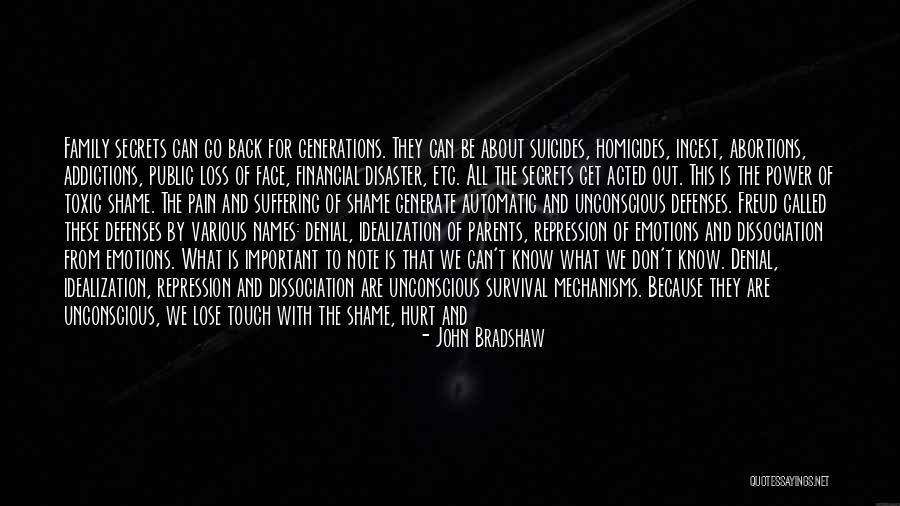
Family secrets can go back for generations. They can be about suicides, homicides, incest, abortions, addictions, public loss of face, financial disaster, etc. All the secrets get acted out. This is the power of toxic shame. The pain and suffering of shame generate automatic and unconscious defenses. Freud called these defenses by various names: denial, idealization of parents, repression of emotions and dissociation from emotions. What is important to note is that we can't know what we don't know. Denial, idealization, repression and dissociation are unconscious survival mechanisms. Because they are unconscious, we lose touch with the shame, hurt and pain they cover up. We cannot heal what we cannot feel. So without recovery, our toxic shame gets carried for generations. — John Bradshaw
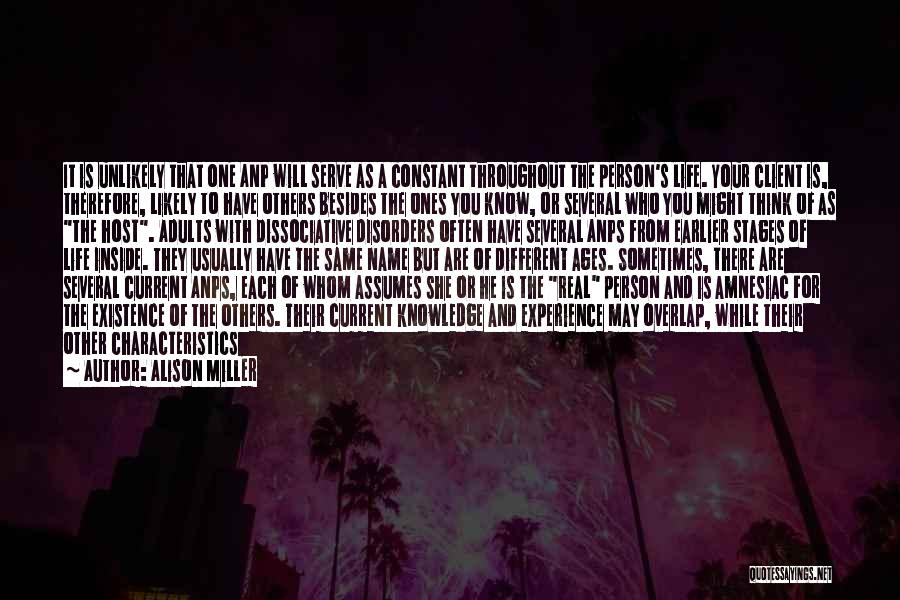
It is unlikely that one ANP will serve as a constant throughout the person's life. Your client is, therefore, likely to have others besides the ones you know, or several who you might think of as "the host". Adults with dissociative disorders often have several ANPs from earlier stages of life inside. They usually have the same name but are of different ages. Sometimes, there are several current ANPs, each of whom assumes she or he is the "real" person and is amnesiac for the existence of the others. Their current knowledge and experience may overlap, while their other characteristics differ somewhat. This makes them glide easily from one to the other, and the therapist can easily miss the switch. p22 — Alison Miller
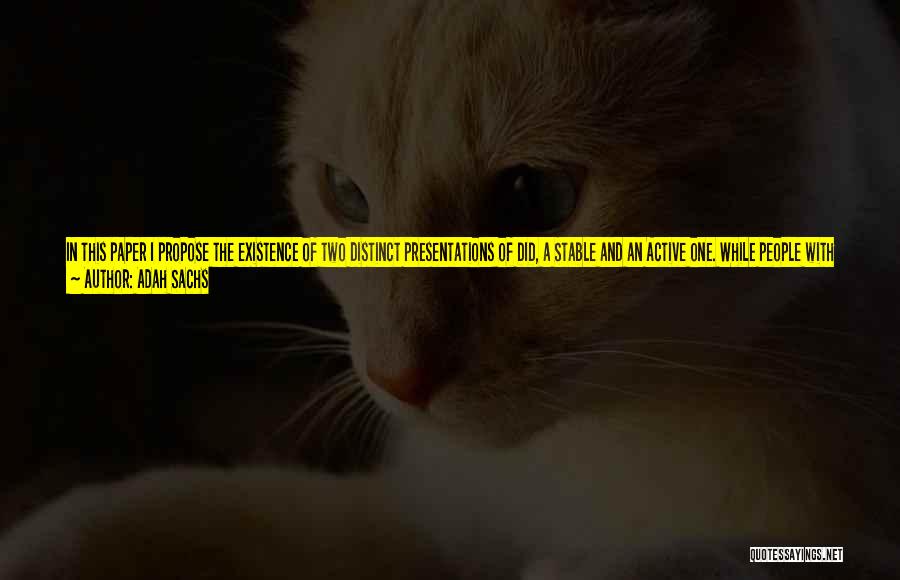
In this paper I propose the existence of two distinct presentations of DID, a Stable and an Active one. While people with Stable DID struggle with their traumatic past, with triggers that re-evoke that past and with the problems of daily functioning with severe dissociation, people with Active DID are, in addition, also engaged in a life of current, on-going involvement in abusive relationships, and do not respond to treatment in the same way as other DID patients. The paper observes these two proposed DID presentations in the context of other trauma-based disorders, through the lens of their attachment relationship. It proposes that the type, intensity and frequency of relational trauma shape - and can thus predict - the resulting mental disorder.
- Through the lens of attachment relationship: Stable DID, Active DID and other trauma-based mental disorders — Adah Sachs
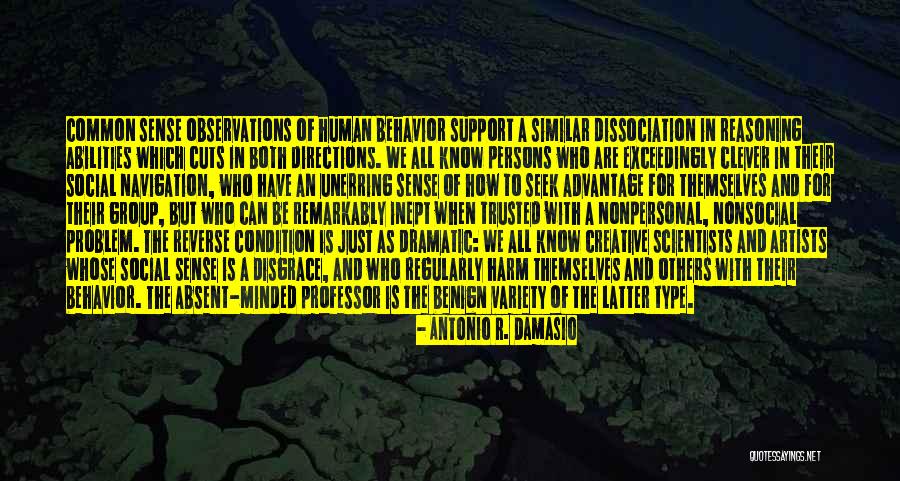
common sense observations of human behavior support a similar dissociation in reasoning abilities which cuts in both directions. We all know persons who are exceedingly clever in their social navigation, who have an unerring sense of how to seek advantage for themselves and for their group, but who can be remarkably inept when trusted with a nonpersonal, nonsocial problem. The reverse condition is just as dramatic: We all know creative scientists and artists whose social sense is a disgrace, and who regularly harm themselves and others with their behavior. The absent-minded professor is the benign variety of the latter type. At work, in these different personality styles, are the presence or absence of what Howard Gardner has called "social intelligence," or the presence or absence of one or the other of his multiple intelligences such as the "mathematical. — Antonio R. Damasio
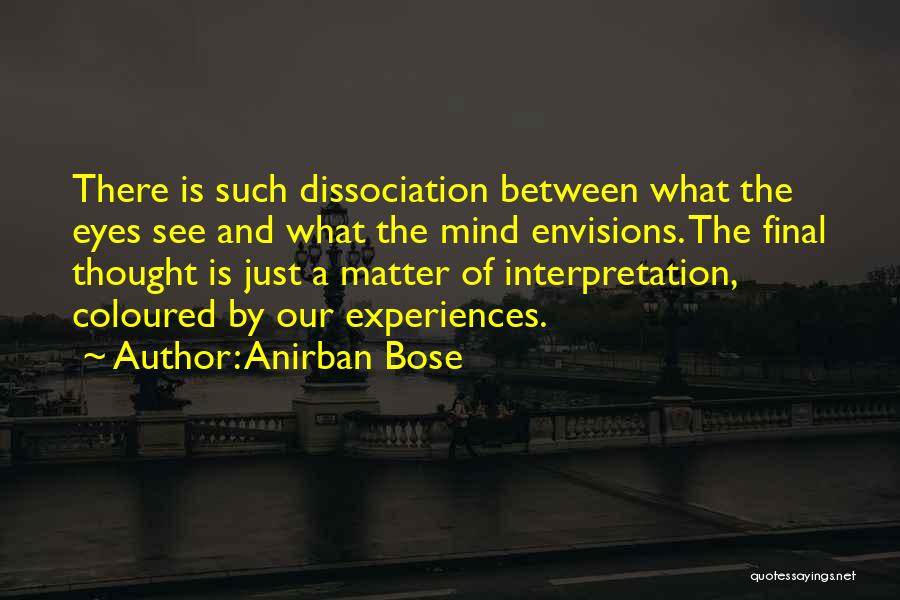
There is such dissociation between what the eyes see and what the mind envisions. The final thought is just a matter of interpretation, coloured by our experiences. — Anirban Bose
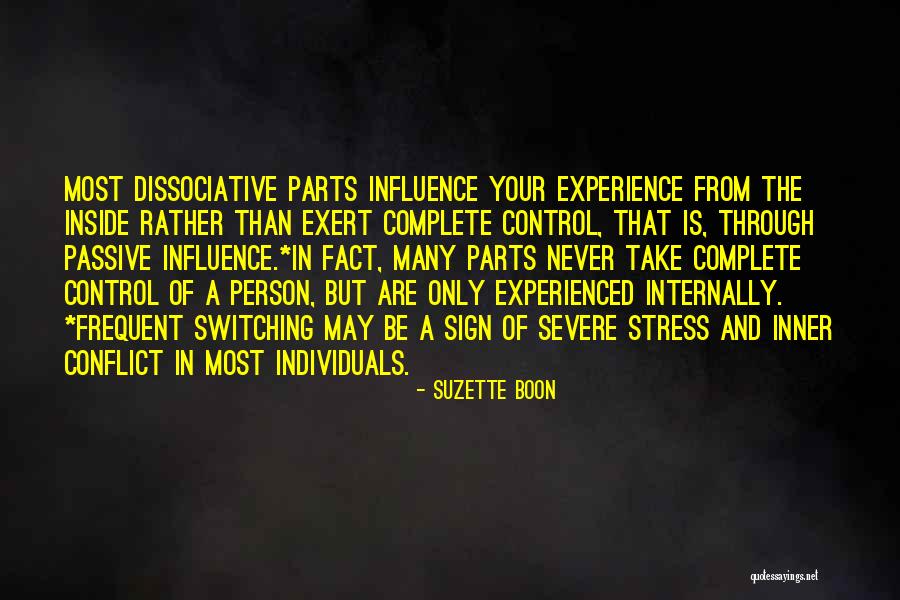
Most dissociative parts influence your experience from the inside rather than exert complete control, that is, through passive influence.
*
In fact, many parts never take complete control of a person, but are only experienced internally.
*
Frequent switching may be a sign of severe stress and inner conflict in most individuals. — Suzette Boon
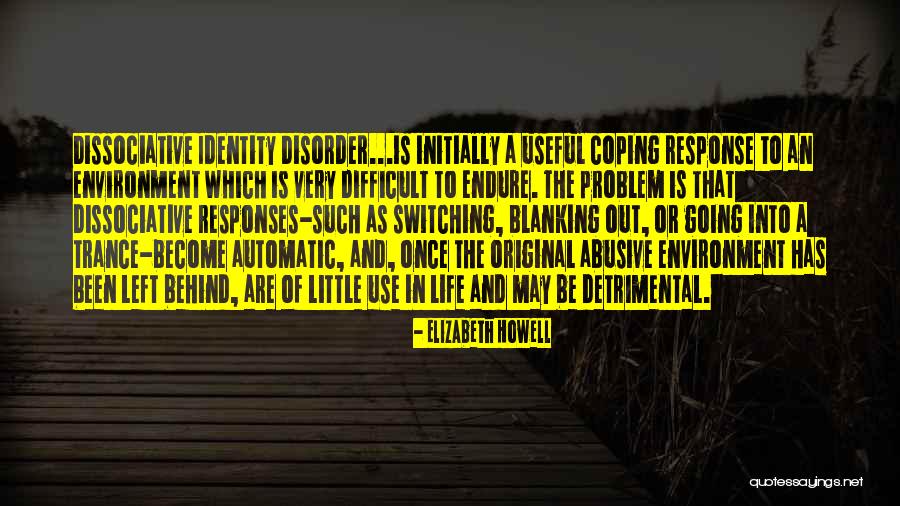
Dissociative Identity Disorder...is initially a useful coping response to an environment which is very difficult to endure. The problem is that dissociative responses-such as switching, blanking out, or going into a trance-become automatic, and, once the original abusive environment has been left behind, are of little use in life and may be detrimental. — Elizabeth Howell
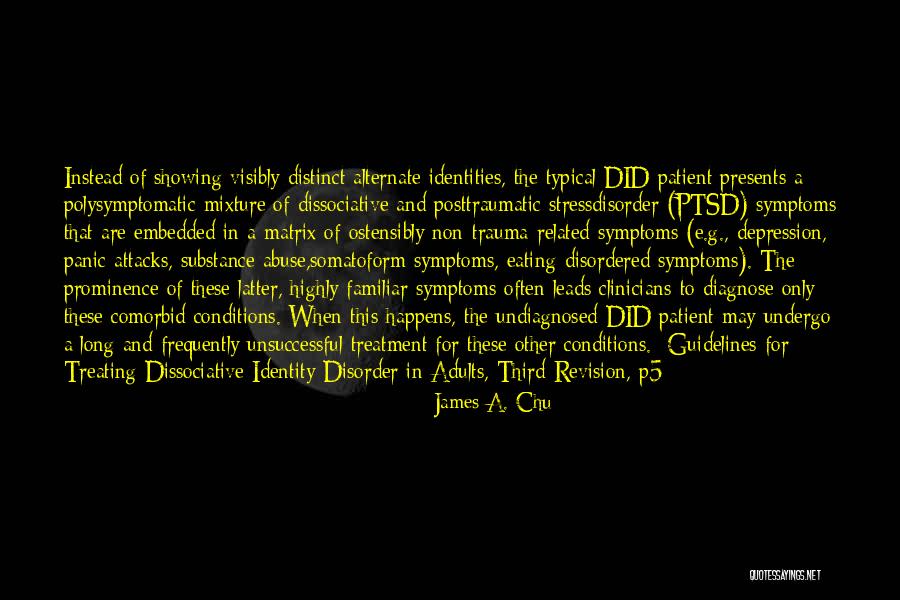
Instead of showing visibly distinct alternate identities, the typical DID patient presents a polysymptomatic mixture of dissociative and posttraumatic stressdisorder (PTSD) symptoms that are embedded in a matrix of ostensibly non-trauma-related symptoms (e.g., depression, panic attacks, substance abuse,somatoform symptoms, eating-disordered symptoms). The prominence of these latter, highly familiar symptoms often leads clinicians to diagnose only these comorbid conditions. When this happens, the undiagnosed DID patient may undergo a long and frequently unsuccessful treatment for these other conditions.
- Guidelines for Treating Dissociative Identity Disorder in Adults, Third Revision, p5 — James A. Chu
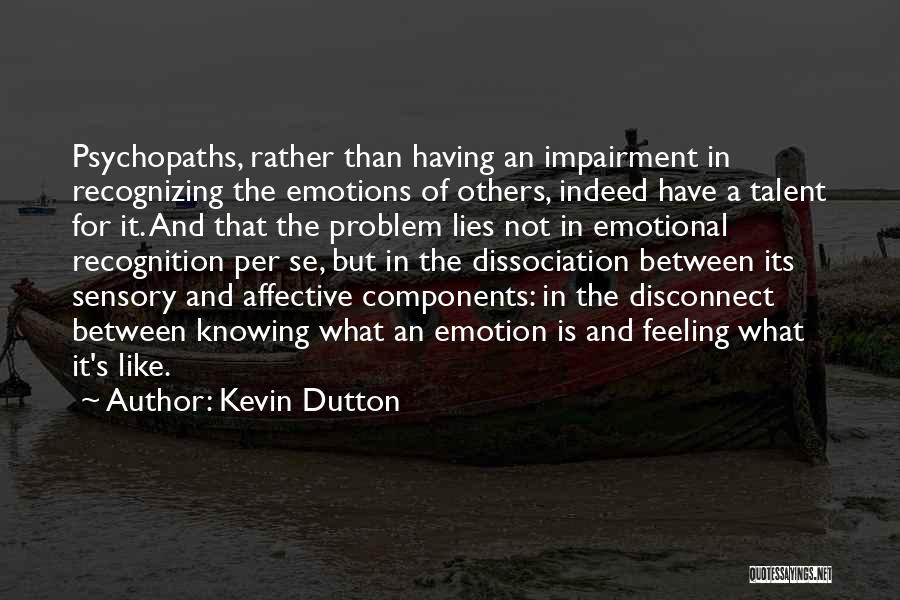
Psychopaths, rather than having an impairment in recognizing the emotions of others, indeed have a talent for it. And that the problem lies not in emotional recognition per se, but in the dissociation between its sensory and affective components: in the disconnect between knowing what an emotion is and feeling what it's like. — Kevin Dutton
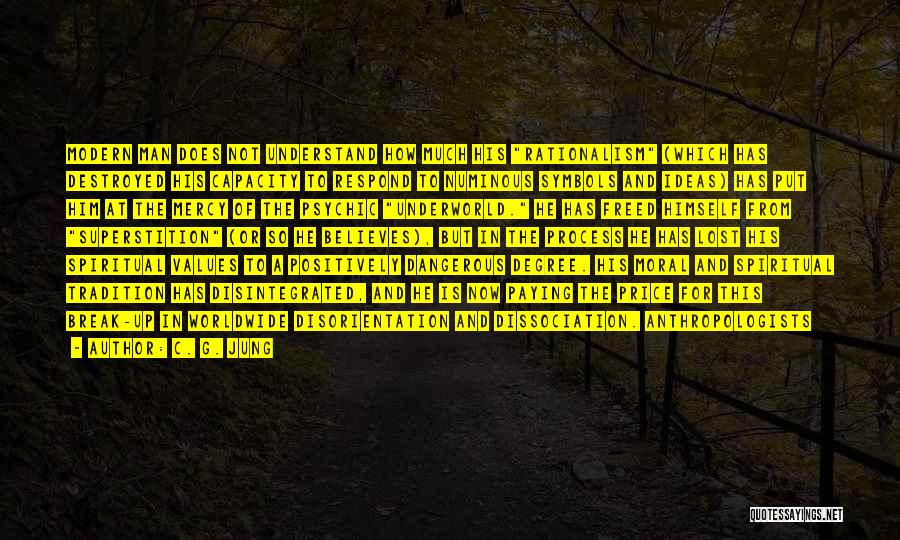
Modern man does not understand how much his "rationalism" (which has destroyed his capacity to respond to numinous symbols and ideas) has put him at the mercy of the psychic "underworld." He has freed himself from "superstition" (or so he believes), but in the process he has lost his spiritual values to a positively dangerous degree. His moral and spiritual tradition has disintegrated, and he is now paying the price for this break-up in worldwide disorientation and dissociation. Anthropologists — C. G. Jung
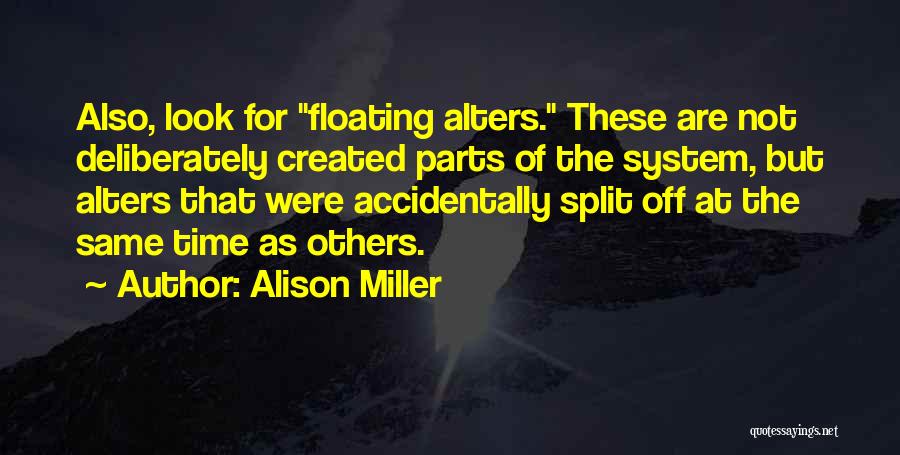
Also, look for "floating alters." These are not deliberately created parts of the system, but alters that were accidentally split off at the same time as others. — Alison Miller
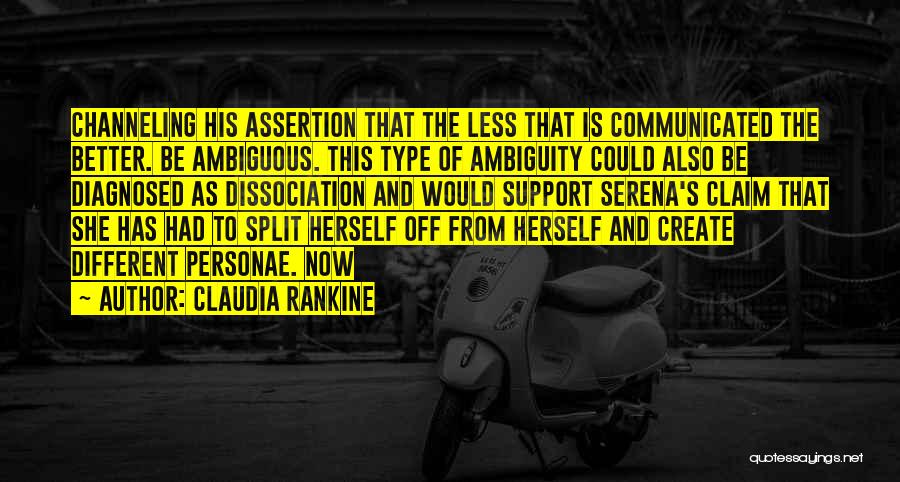
channeling his assertion that the less that is communicated the better. Be ambiguous. This type of ambiguity could also be diagnosed as dissociation and would support Serena's claim that she has had to split herself off from herself and create different personae. Now — Claudia Rankine
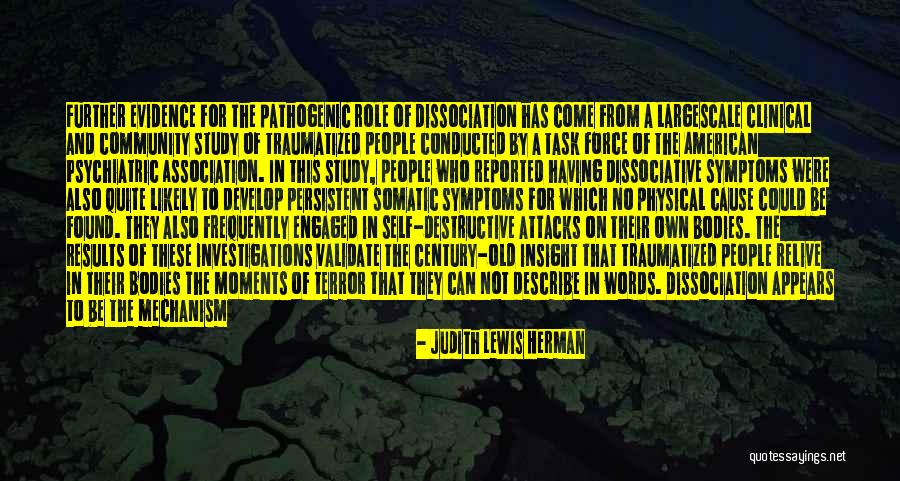
Further evidence for the pathogenic role of dissociation has come from a largescale clinical and community study of traumatized people conducted by a task force of the American Psychiatric Association. In this study, people who reported having dissociative symptoms were also quite likely to develop persistent somatic symptoms for which no physical cause could be found. They also frequently engaged in self-destructive attacks on their own bodies. The results of these investigations validate the century-old insight that traumatized people relive in their bodies the moments of terror that they can not describe in words. Dissociation appears to be the mechanism by which intense sensory and emotional experiences are disconnected from the social domain of language and memory, the internal mechanism by which terrorized people are silenced. — Judith Lewis Herman

The difficulties in diagnosing DID result primarily from lack of education among clinicians about dissociation, dissociative disorders, and the effects of psychological trauma, as well as from clinician bias. This leads to limited clinical suspicion about dissociative disorders and misconceptions about their clinical presentation. Most clinicians have been taught (or assume) that DID is a rare disorder with a florid, dramatic presentation. Although DID is a relatively common disorder, R. P. Kluft (2009) observed that "only 6% make their DID obvious on an ongoing basis" (p. 600).
- Guidelines for Treating Dissociative Identity Disorder in Adults, Third Revision, p4-5 — James A. Chu

If you want to know the real meaning of pornography, it is the utter dissociation of love and sex, the banishment of love from the sexual arena. — Martin Amis
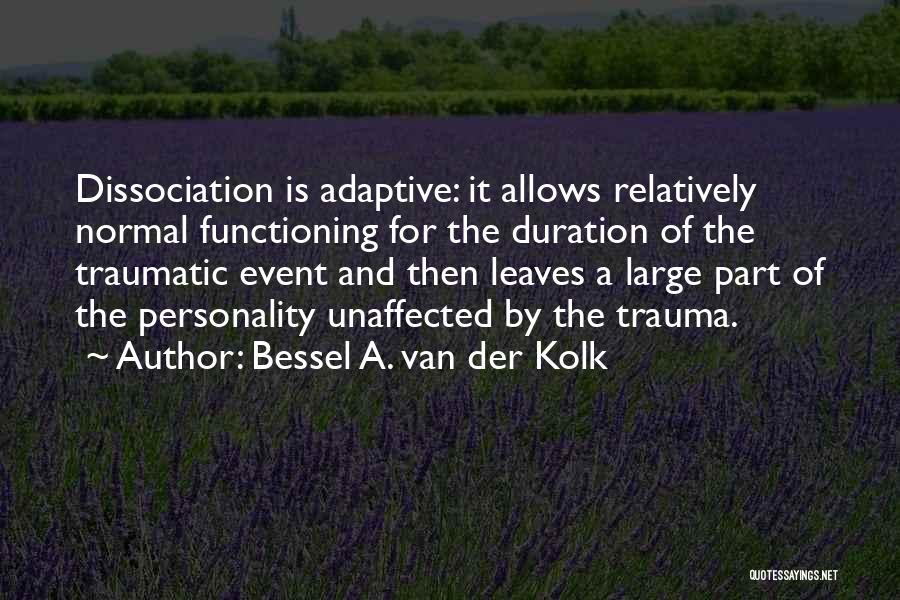
Dissociation is adaptive: it allows relatively normal functioning for the duration of the traumatic event and then leaves a large part of the personality unaffected by the trauma. — Bessel A. Van Der Kolk
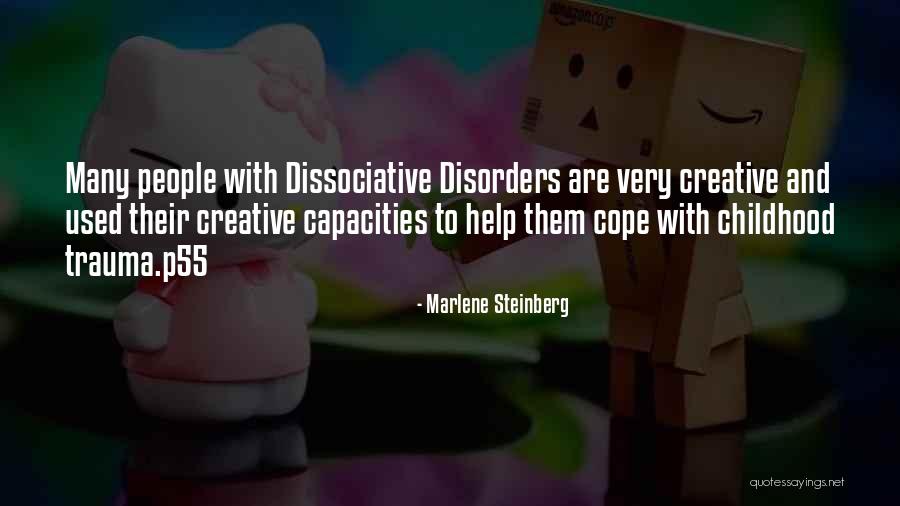
Many people with Dissociative Disorders are very creative and used their creative capacities to help them cope with childhood trauma.p55 — Marlene Steinberg
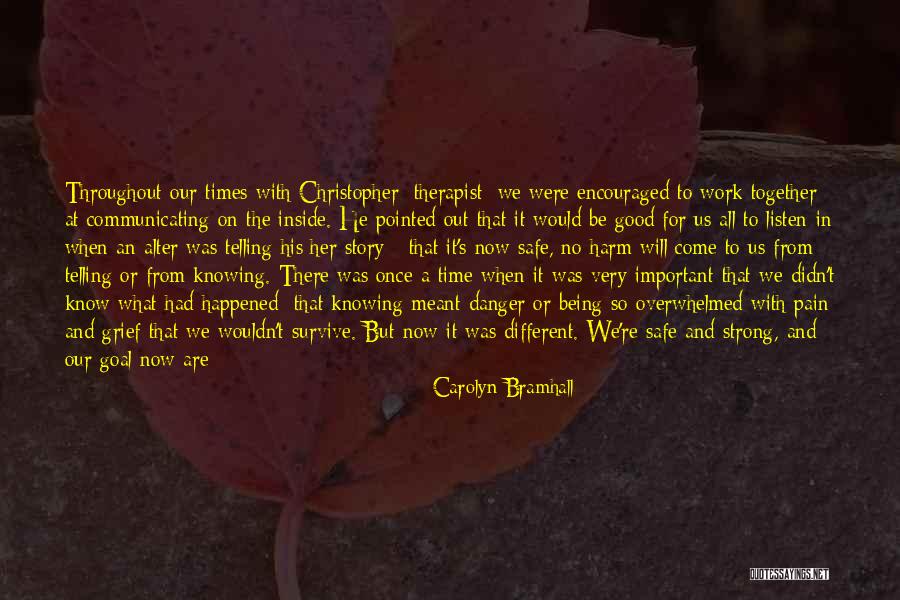
Throughout our times with Christopher [therapist] we were encouraged to work together at communicating on the inside. He pointed out that it would be good for us all to listen-in when an alter was telling his/her story - that it's now safe, no harm will come to us from telling or from knowing. There was once a time when it was very important that we didn't know what had happened; that knowing meant danger or being so overwhelmed with pain and grief that we wouldn't survive. But now it was different. We're safe and strong, and our goal now are to uncover the grisly truth of what's happened to us, so that it's no longer a powerful secret. We can look at it and face the past for what it is - old memories of old events. Today is now,and we can choose to live a different way and believe different things. We were once powerless and vulnerable, but now we were in a position to make choices. We had control over our life. — Carolyn Bramhall
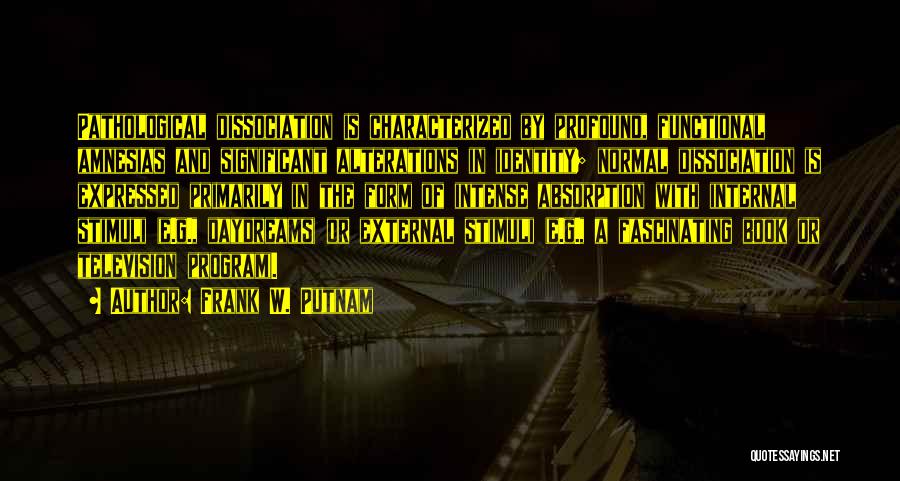
Pathological dissociation is characterized by profound, functional amnesias and significant alterations in identity; normal dissociation is expressed primarily in the form of intense absorption with internal stimuli (e.g., daydreams) or external stimuli (e.g., a fascinating book or television program). — Frank W. Putnam

The most chronic and complex of the dissociative disorders, multiple personality disorder, was renamed multiple personality disorder, was renamed 'dissociative identity disorder' in 1994 in DSM-IV (American Psychiatric Association). The rationale for the name change, was among other things, to clarify that there are not literally separate personalities in a person with dissociative identity disorder; 'personalities' was a historical term for the fragmented identity states that characterize the condition. — Colin A. Ross
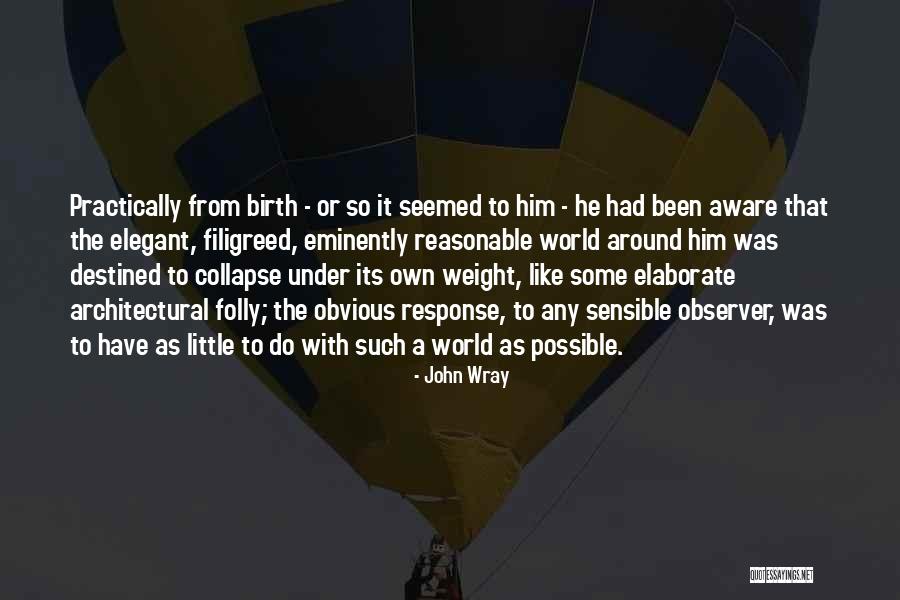
Practically from birth - or so it seemed to him - he had been aware that the elegant, filigreed, eminently reasonable world around him was destined to collapse under its own weight, like some elaborate architectural folly; the obvious response, to any sensible observer, was to have as little to do with such a world as possible. — John Wray
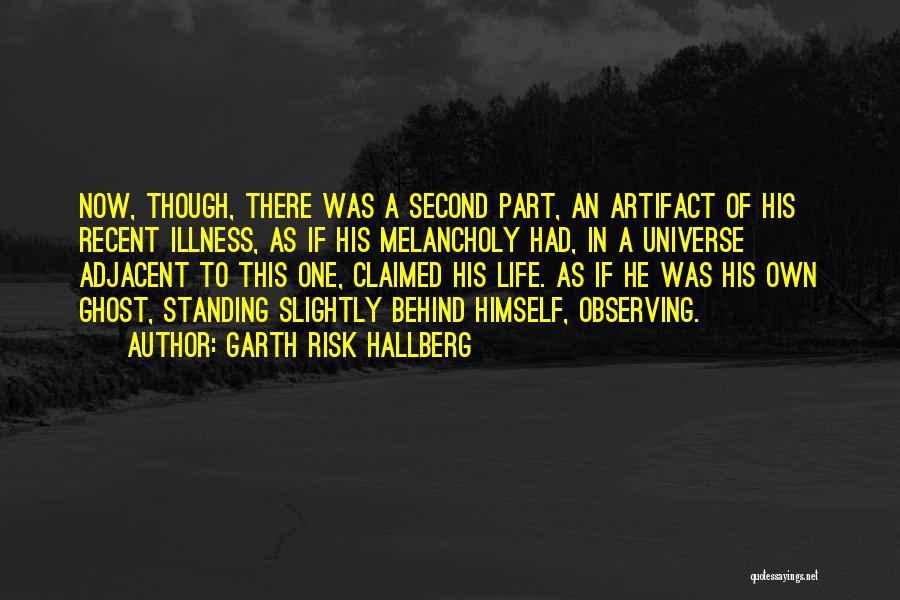
Now, though, there was a second part, an artifact of his recent illness, as if his melancholy had, in a universe adjacent to this one, claimed his life. As if he was his own ghost, standing slightly behind himself, observing. — Garth Risk Hallberg

Joe knew that for some, really for most, the derivations of belladonna that blurred their vision and caused their hearts to race would, as well, hasten their forgetting of detail. They would not recall, not readily, any sense of pain or shame or doubt or threat of danger.
[]
There were always children to be used. Members were obliged to offer their children, although not necessarily every child in a family was used. Some were found to be not suited for the rigor. Some were left alone so that if the involved children in a family were to attempt to tell, siblings could not corroborate their experience. — Judith Spencer
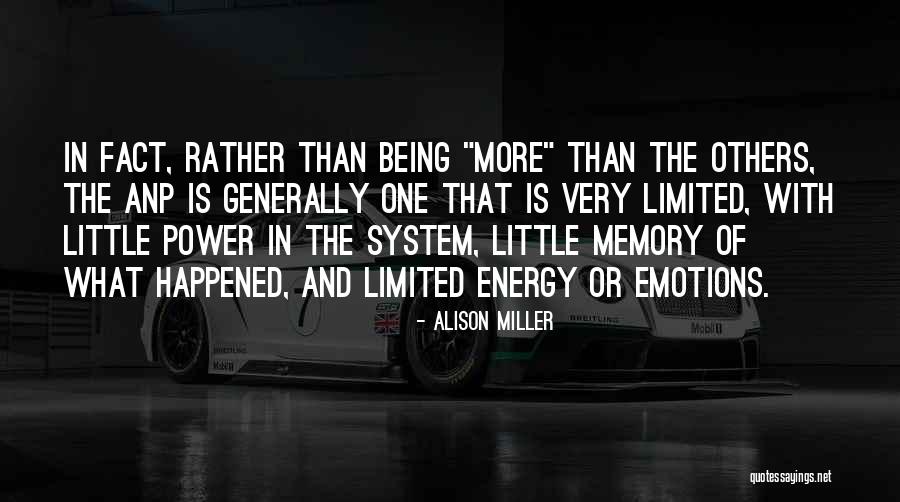
In fact, rather than being "more" than the others, the ANP is generally one that is very limited, with little power in the system, little memory of what happened, and limited energy or emotions. — Alison Miller
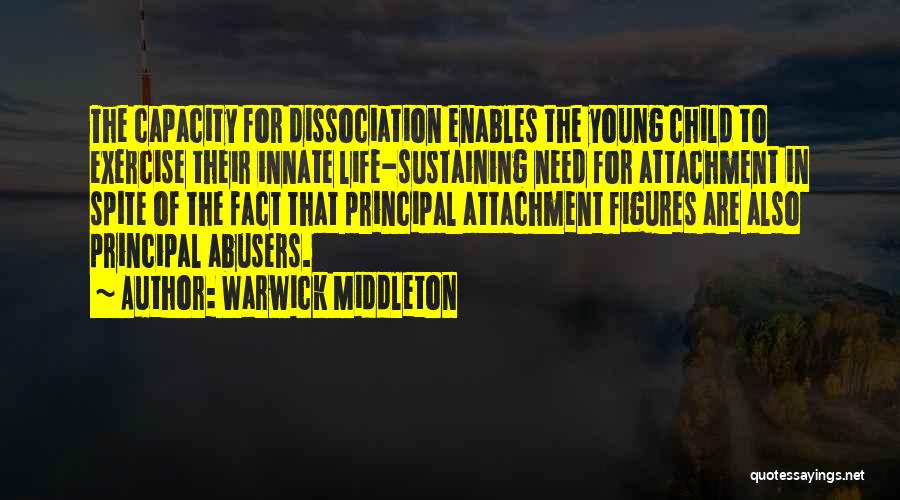
The capacity for dissociation enables the young child to exercise their innate life-sustaining need for attachment in spite of the fact that principal attachment figures are also principal abusers. — Warwick Middleton
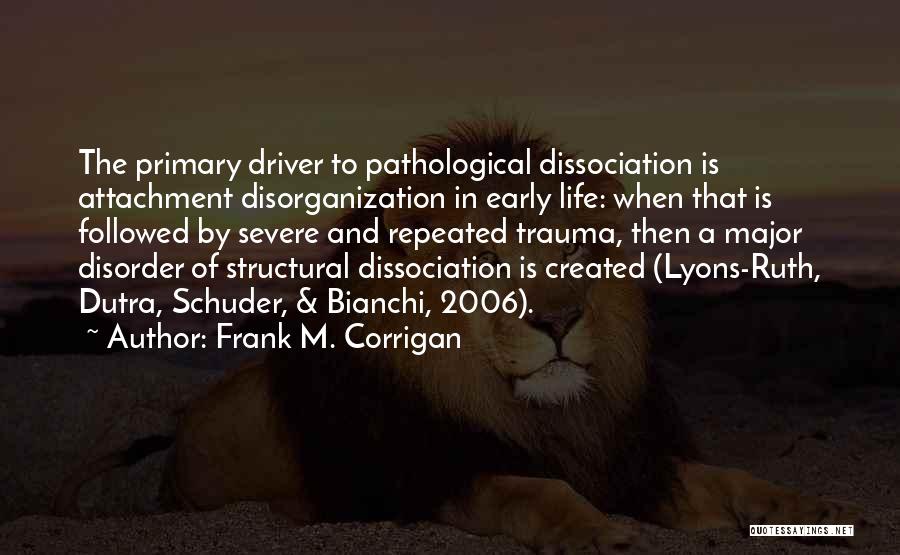
The primary driver to pathological dissociation is attachment disorganization in early life: when that is followed by severe and repeated trauma, then a major disorder of structural dissociation is created (Lyons-Ruth, Dutra, Schuder, & Bianchi, 2006). — Frank M. Corrigan
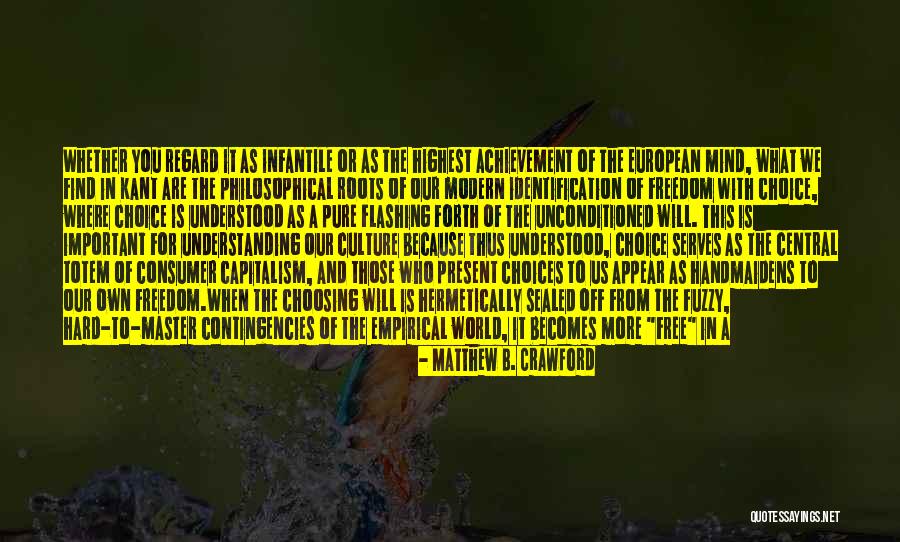
Whether you regard it as infantile or as the highest achievement of the European mind, what we find in Kant are the philosophical roots of our modern identification of freedom with choice, where choice is understood as a pure flashing forth of the unconditioned will. This is important for understanding our culture because thus understood, choice serves as the central totem of consumer capitalism, and those who present choices to us appear as handmaidens to our own freedom.
When the choosing will is hermetically sealed off from the fuzzy, hard-to-master contingencies of the empirical world, it becomes more "free" in a sense: free for the kind of neurotic dissociation from reality that opens the door wide for others to leap in on our behalf, and present options that are available to us without the world-disclosing effort of skillful engagement. — Matthew B. Crawford
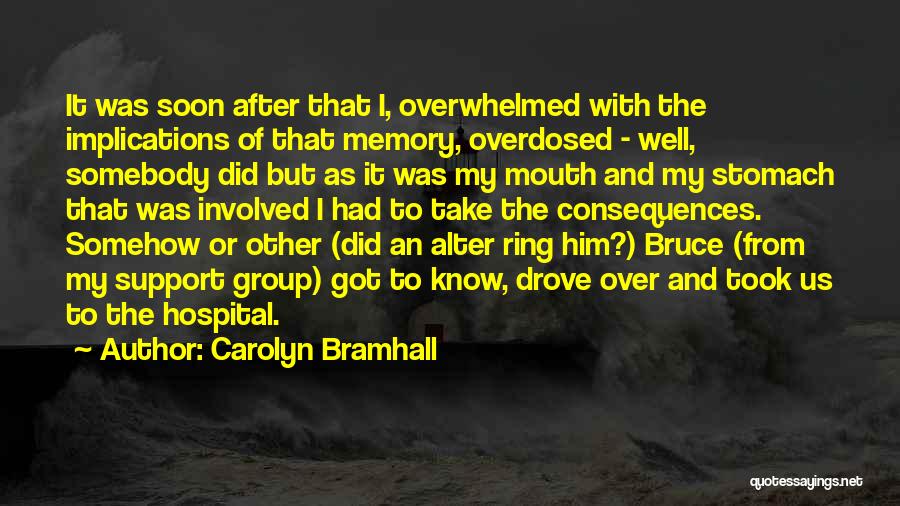
It was soon after that I, overwhelmed with the implications of that memory, overdosed - well, somebody did but as it was my mouth and my stomach that was involved I had to take the consequences. Somehow or other (did an alter ring him?) Bruce (from my support group) got to know, drove over and took us to the hospital. — Carolyn Bramhall

-If I somehow possessed a set of videotapes that contained all the most significant events of your childhood, in their entirety, would you want to see them?
-Absolutely. Right this very second.
-But why? Don't you think some of the tapes would be very sad?
-Most of them, yes. But if I could see them, then I could have them in my brain like regular memories-horrible memories, yes, but regular memories, not sinister little ghosts in my head that pop out of some part of me I don't even know, and take the rest of me away. Do you know what I mean?
-I think so, If you have to remeber, you'd rather do it in the front of your brain than in the back. — Martha Stout

Because of dissociation, many victims are able to remember the abuse only when a certain object, smell, color, scene, or experience triggers a sudden, severe reaction. During a flashback one seems to see, feel, hear, smell, or taste something from the past as if it were actually happening in the present. In a visual flashback, you actually see the scene of your abuse, or you may see an object or image that reminds you or is symbolic of your abuse. — Beverly Engel

Programming is the act of installing internal, pre-established reactions to external stimuli so that a person will automatically react in a predetermined manner to things like an auditory, visual or tactile signal or perform a specific set of actions according to a date and/or time. — Alison Miller
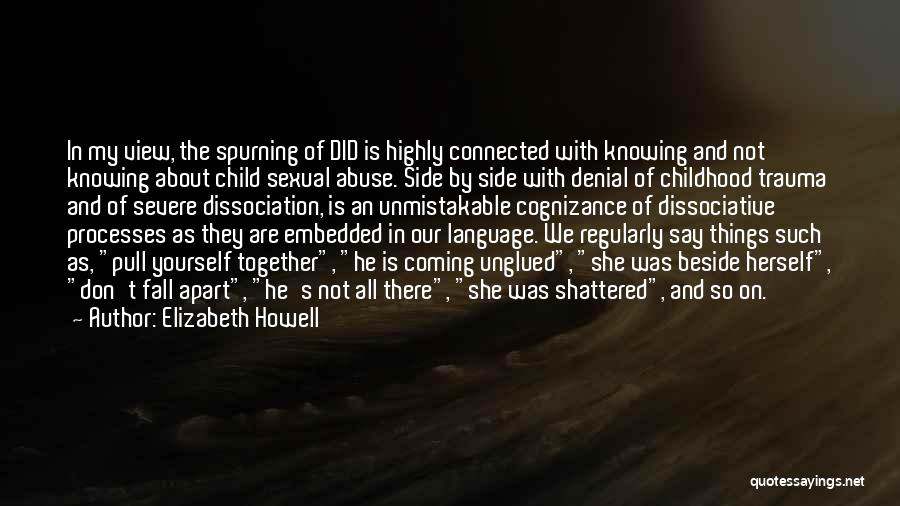
In my view, the spurning of DID is highly connected with knowing and not knowing about child sexual abuse. Side by side with denial of childhood trauma and of severe dissociation, is an unmistakable cognizance of dissociative processes as they are embedded in our language. We regularly say things such as, "pull yourself together", "he is coming unglued", "she was beside herself", "don't fall apart", "he's not all there", "she was shattered", and so on. — Elizabeth Howell
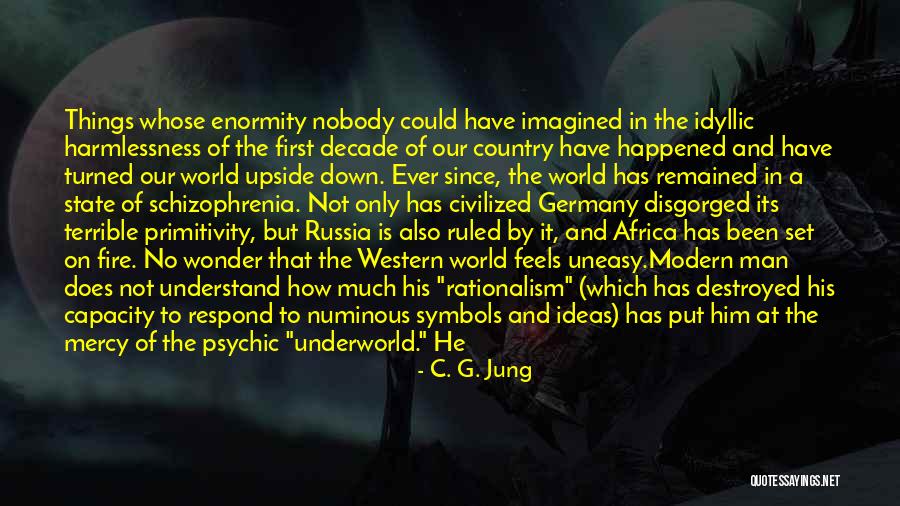
Things whose enormity nobody could have imagined in the idyllic harmlessness of the first decade of our country have happened and have turned our world upside down. Ever since, the world has remained in a state of schizophrenia. Not only has civilized Germany disgorged its terrible primitivity, but Russia is also ruled by it, and Africa has been set on fire. No wonder that the Western world feels uneasy.
Modern man does not understand how much his "rationalism" (which has destroyed his capacity to respond to numinous symbols and ideas) has put him at the mercy of the psychic "underworld." He has freed himself from "superstition" (or so he believes), but in the process he has lost his spiritual values to a positively dangerous degree. His moral and spiritual tradition has disintegrated, and he is now paying the price for this break-up in world-wide disorientation and dissociation. — C. G. Jung
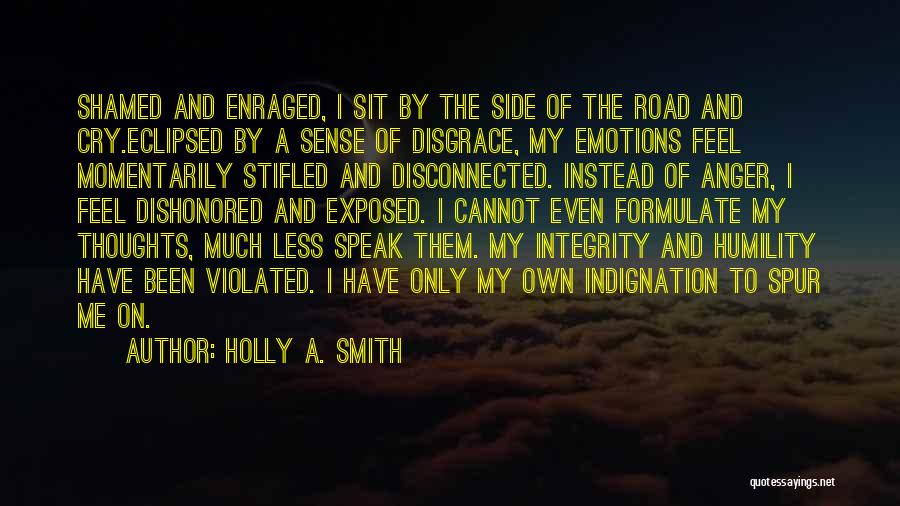
Shamed and enraged, I sit by the side of the road and cry.
Eclipsed by a sense of disgrace, my emotions feel momentarily stifled and disconnected. Instead of anger, I feel dishonored and exposed. I cannot even formulate my thoughts, much less speak them. My integrity and humility have been violated. I have only my own indignation to spur me on. — Holly A. Smith
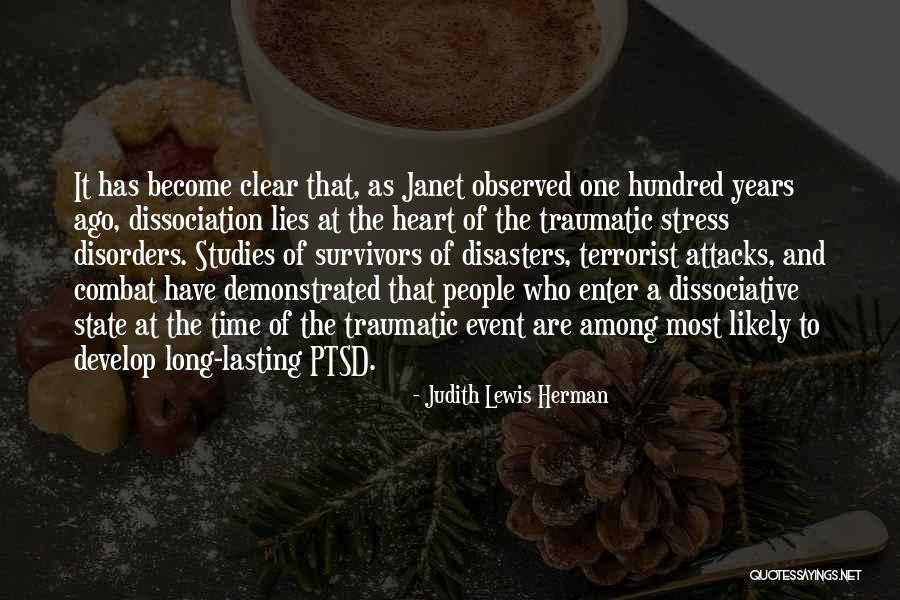
It has become clear that, as Janet observed one hundred years ago, dissociation lies at the heart of the traumatic stress disorders. Studies of survivors of disasters, terrorist attacks, and combat have demonstrated that people who enter a dissociative state at the time of the traumatic event are among most likely to develop long-lasting PTSD. — Judith Lewis Herman
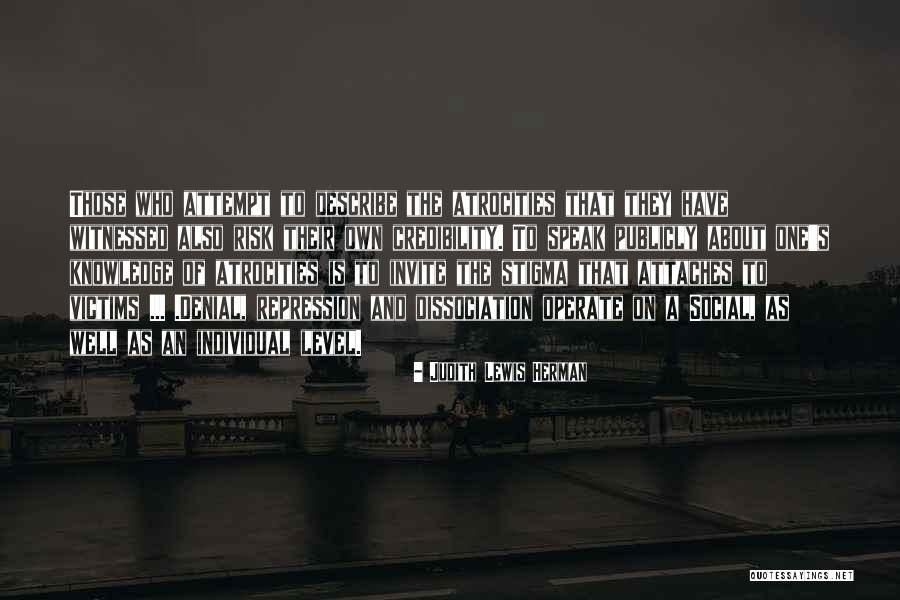
Those who attempt to describe the atrocities that they have witnessed also risk their own credibility.
To speak publicly about one's knowledge of atrocities is to invite the stigma that attaches to victims ... .
Denial, repression and dissociation operate on a Social, as well as an individual level. — Judith Lewis Herman
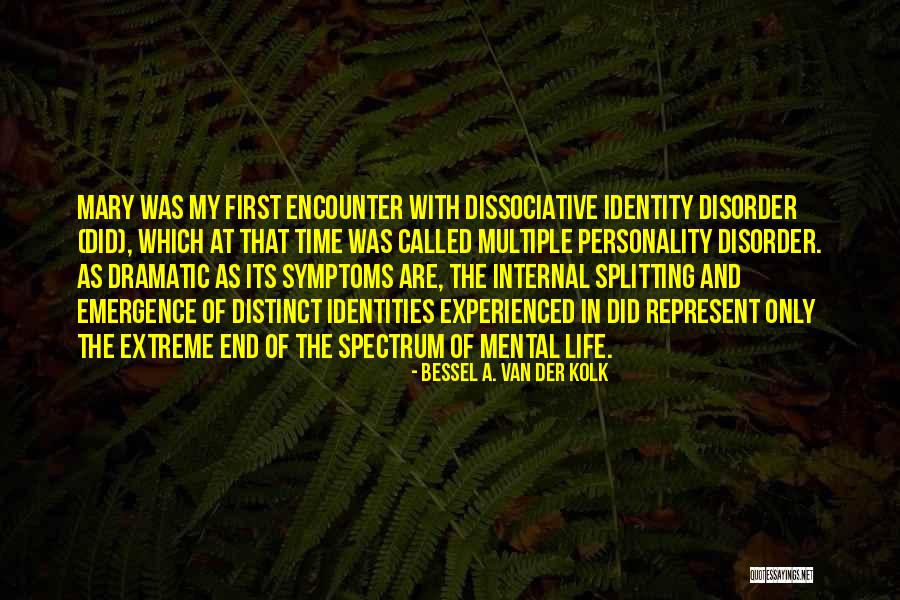
Mary was my first encounter with dissociative identity disorder (DID), which at that time was called multiple personality disorder. As dramatic as its symptoms are, the internal splitting and emergence of distinct identities experienced in DID represent only the extreme end of the spectrum of mental life. — Bessel A. Van Der Kolk
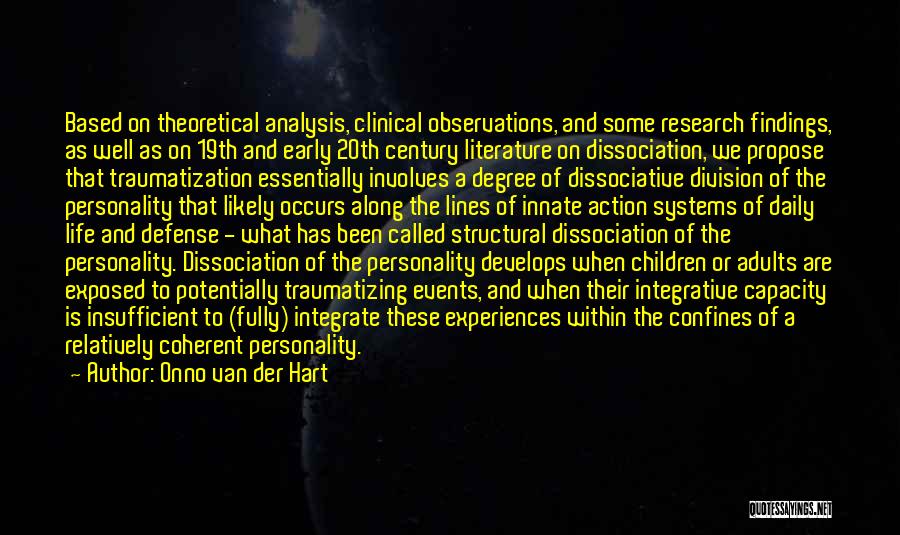
Based on theoretical analysis, clinical observations, and some research findings, as well as on 19th and early 20th century literature on dissociation, we propose that traumatization essentially involves a degree of dissociative division of the personality that likely occurs along the lines of innate action systems of daily life and defense - what has been called structural dissociation of the personality. Dissociation of the personality develops when children or adults are exposed to potentially traumatizing events, and when their integrative capacity is insufficient to (fully) integrate these experiences within the confines of a relatively coherent personality. — Onno Van Der Hart

DURING THAT YEAR, and especially in the winter months, he found himself returning more and more frequently to such a state of unreality; at will, he seemed able to remove his consciousness from the body that contained it, and he observed himself as if he were an oddly familiar stranger doing the oddly familiar things that he had to do. It was a dissociation that he had never felt before; he knew that he ought to be troubled by it, but he was numb, and he could not convince himself that it mattered. — John Edward Williams

In my mind, I built stairways. At the end of the stairways, I imagined rooms. These were high, airy places with big windows and a cool breeze moving through. I imagined one room opening brightly onto another room until I'd built a house, a place with hallways and more staircases. I built many houses, one after another, and those gave rise to a city -- a calm, sparkling city near the ocean, a place like Vancouver. I put myself there, and that's where I lived, in the wide-open sky of my mind. I made friends and read books and went running on a footpath in a jewel-green park along the harbour. I ate pancakes drizzled in syrup and took baths and watched sunlight pour through trees. This wasn't longing, and it wasn't insanity. It was relief. It got me through. — Amanda Lindhout
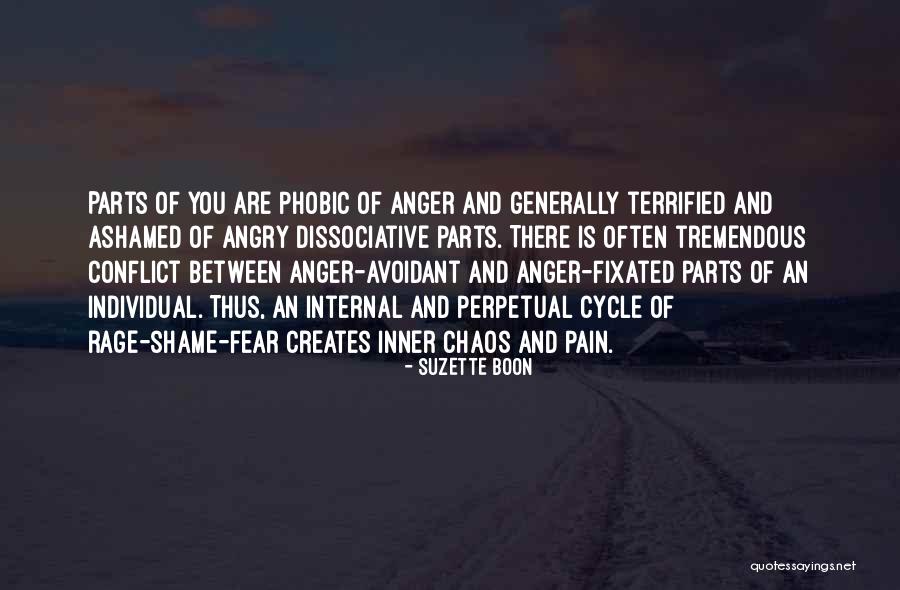
Parts of you are phobic of anger and generally terrified and ashamed of angry dissociative parts. There is often tremendous conflict between anger-avoidant and anger-fixated parts of an individual. Thus, an internal and perpetual cycle of rage-shame-fear creates inner chaos and pain. — Suzette Boon
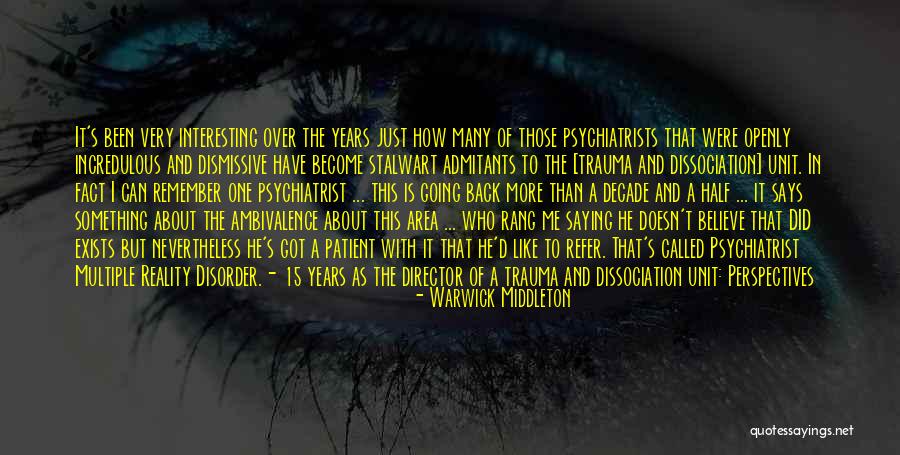
It's been very interesting over the years just how many of those psychiatrists that were openly incredulous and dismissive have become stalwart admitants to the [trauma and dissociation] unit. In fact I can remember one psychiatrist ... this is going back more than a decade and a half ... it says something about the ambivalence about this area ... who rang me saying he doesn't believe that DID exists but nevertheless he's got a patient with it that he'd like to refer. That's called Psychiatrist Multiple Reality Disorder.
- 15 years as the director of a trauma and dissociation unit: Perspectives on Trauma-informed Care — Warwick Middleton

I thought if I could touch this place or feel it
this brokenness inside me might start healing.
Out here its like I'm someone else,
I thought that maybe I could find myself
if I could just come in I swear I'll leave.
Won't take nothing but a memory
from the house that built me. — Miranda Lambert
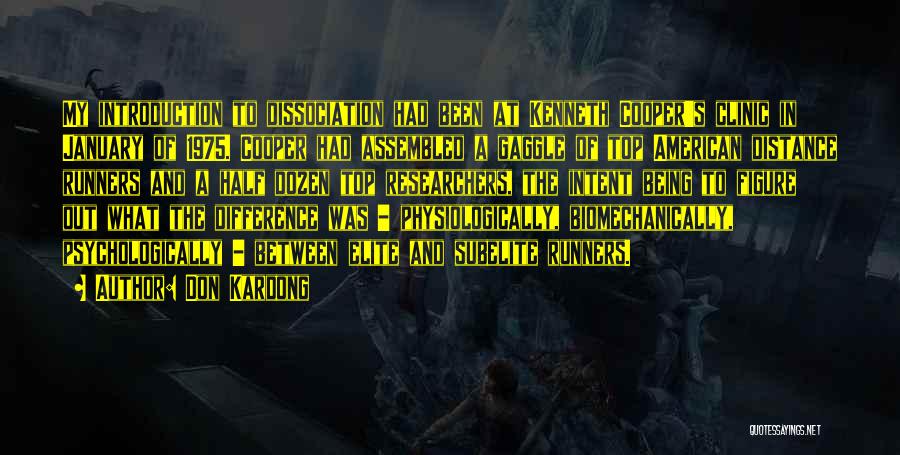
My introduction to dissociation had been at Kenneth Cooper's clinic in January of 1975. Cooper had assembled a gaggle of top American distance runners and a half dozen top researchers, the intent being to figure out what the difference was - physiologically, biomechanically, psychologically - between elite and subelite runners. — Don Kardong
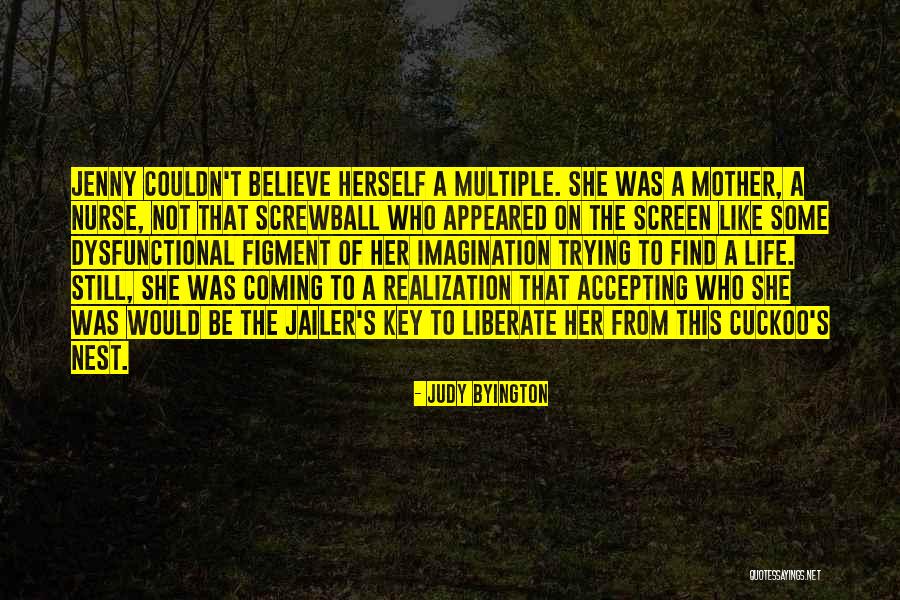
Jenny couldn't believe herself a multiple. She was a mother, a nurse, not that screwball who appeared on the screen like some dysfunctional figment of her imagination trying to find a life. Still, she was coming to a realization that accepting who she was would be the jailer's key to liberate her from this cuckoo's nest. — Judy Byington

It is the power of the mind to be unconquerable. — Seneca.
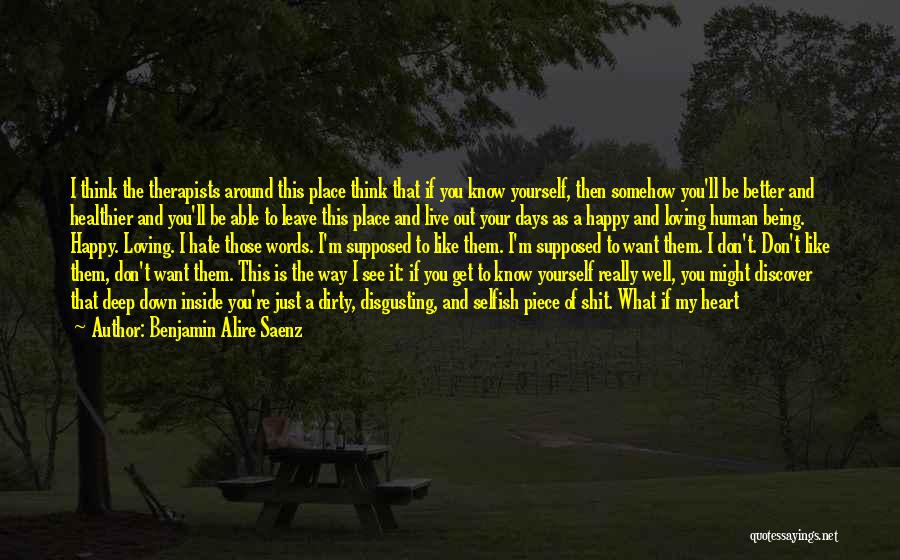
I think the therapists around this place think that if you know yourself, then somehow you'll be better and healthier and you'll be able to leave this place and live out your days as a happy and loving human being. Happy. Loving. I hate those words. I'm supposed to like them. I'm supposed to want them. I don't. Don't like them, don't want them. This is the way I see it: if you get to know yourself really well, you might discover that deep down inside you're just a dirty, disgusting, and selfish piece of shit. What if my heart is all rotted out and corrupted? What about that? What am I supposed to do with that information? Just tell me that. Most of the time I get the feeling that I'm just an animal disguised as an eighteen-year-old guy. At least I'm hoping that maybe deep down inside I'm a coyote. — Benjamin Alire Saenz
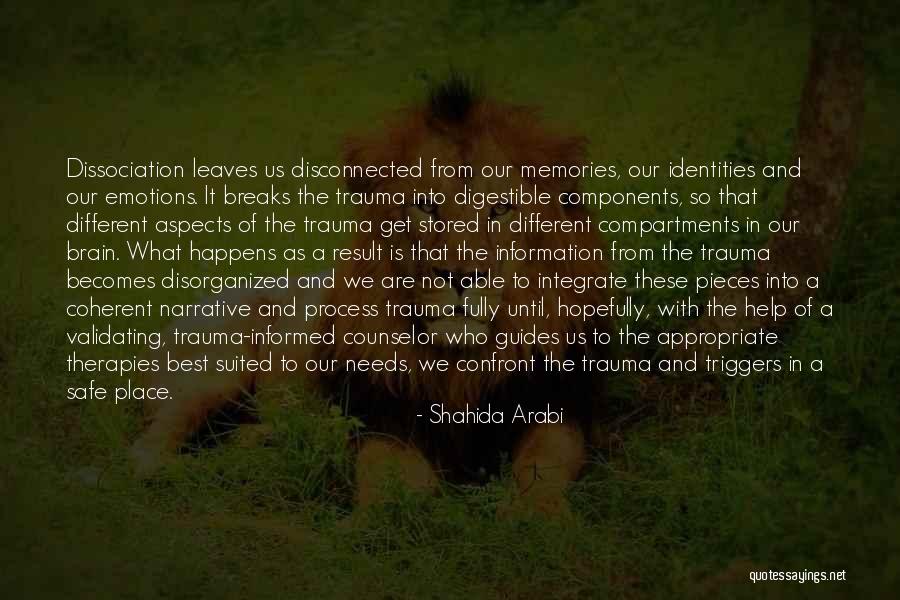
Dissociation leaves us disconnected from our memories, our identities and our emotions. It breaks the trauma into digestible components, so that different aspects of the trauma get stored in different compartments in our brain. What happens as a result is that the information from the trauma becomes disorganized and we are not able to integrate these pieces into a coherent narrative and process trauma fully until, hopefully, with the help of a validating, trauma-informed counselor who guides us to the appropriate therapies best suited to our needs, we confront the trauma and triggers in a safe place. — Shahida Arabi
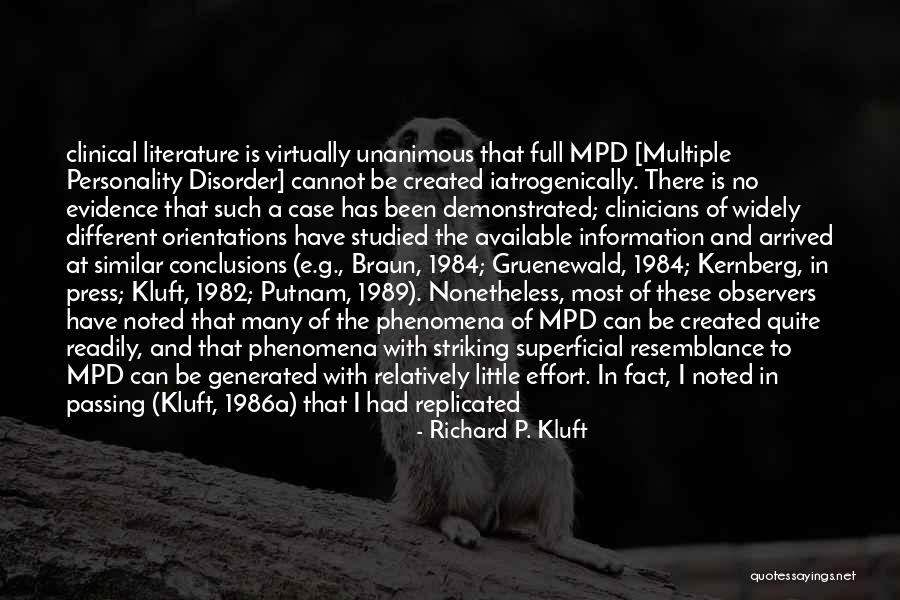
clinical literature is virtually unanimous that full MPD [Multiple Personality Disorder] cannot be created iatrogenically. There is no evidence that such a case has been demonstrated; clinicians of widely different orientations have studied the available information and arrived at similar conclusions (e.g., Braun, 1984; Gruenewald, 1984; Kernberg, in press; Kluft, 1982; Putnam, 1989). Nonetheless, most of these observers have noted that many of the phenomena of MPD can be created quite readily, and that phenomena with striking superficial resemblance to MPD can be generated with relatively little effort. In fact, I noted in passing (Kluft, 1986a) that I had replicated the interventions of Harriman (1942,1943), Leavitt (1947), and Kampman (1976), and found the resultant phenomena clearly distinguishable from clinical MPD.
(from Kluft, R. P. (1989). Dissociation: Vol. 2, No. 2, p. 083-091: Iatrongenic creation of new alter personalities) — Richard P. Kluft
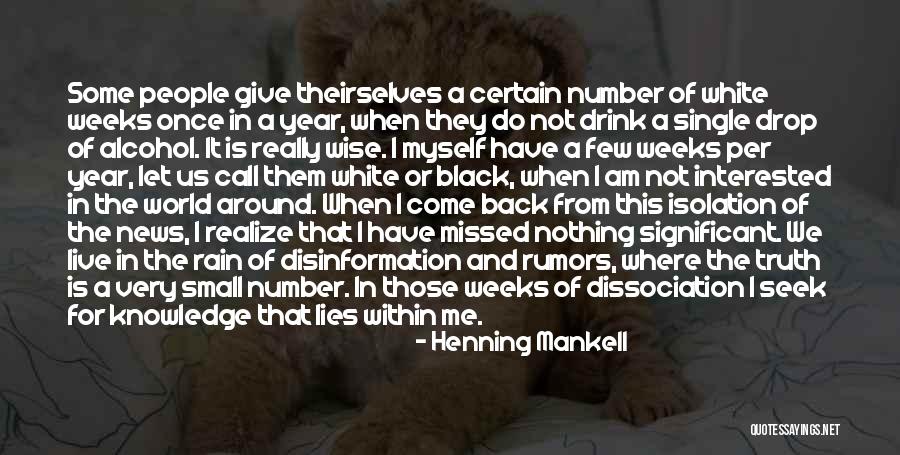
Some people give theirselves a certain number of white weeks once in a year, when they do not drink a single drop of alcohol. It is really wise. I myself have a few weeks per year, let us call them white or black, when I am not interested in the world around. When I come back from this isolation of the news, I realize that I have missed nothing significant. We live in the rain of disinformation and rumors, where the truth is a very small number. In those weeks of dissociation I seek for knowledge that lies within me. — Henning Mankell
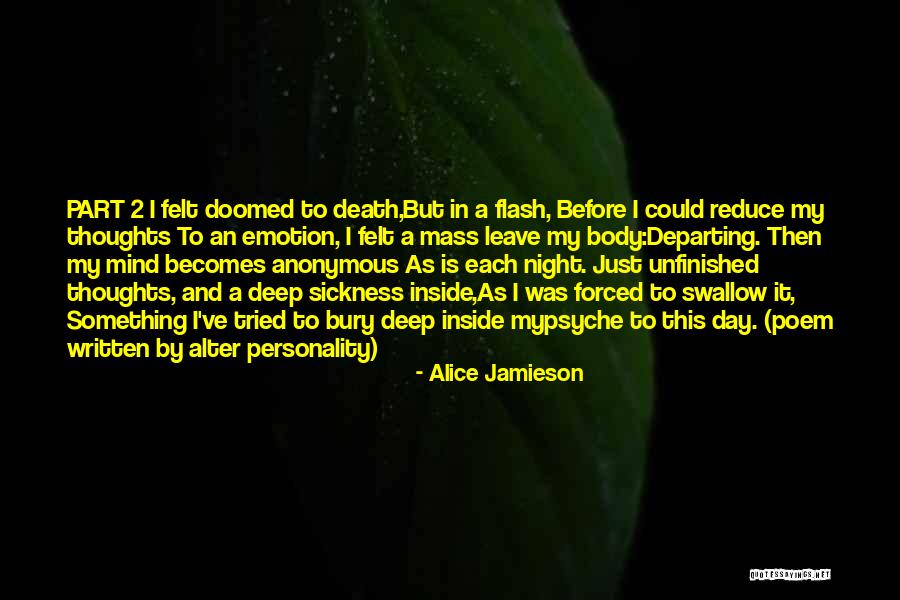
PART 2
I felt doomed to death,
But in a flash,
Before I could reduce my thoughts
To an emotion,
I felt a mass leave my body:
Departing.
Then my mind becomes anonymous
As is each night.
Just unfinished thoughts,
and a deep sickness inside,
As I was forced to swallow it,
Something I've tried to bury deep inside my
psyche to this day.
(poem written by alter personality) — Alice Jamieson
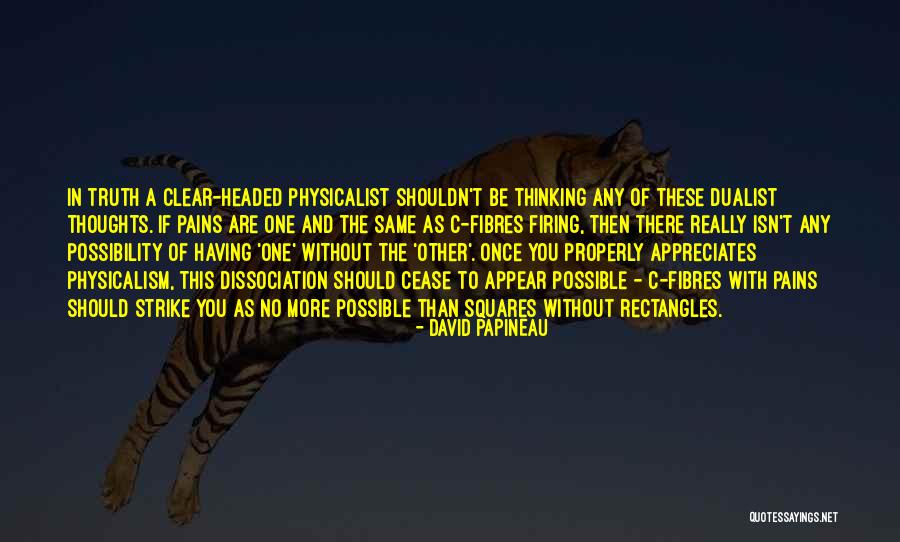
In truth a clear-headed physicalist shouldn't be thinking any of these dualist thoughts. If pains are one and the same as C-fibres firing, then there really isn't any possibility of having 'one' without the 'other'. Once you properly appreciates physicalism, this dissociation should cease to appear possible - C-fibres with pains should strike you as no more possible than squares without rectangles. — David Papineau
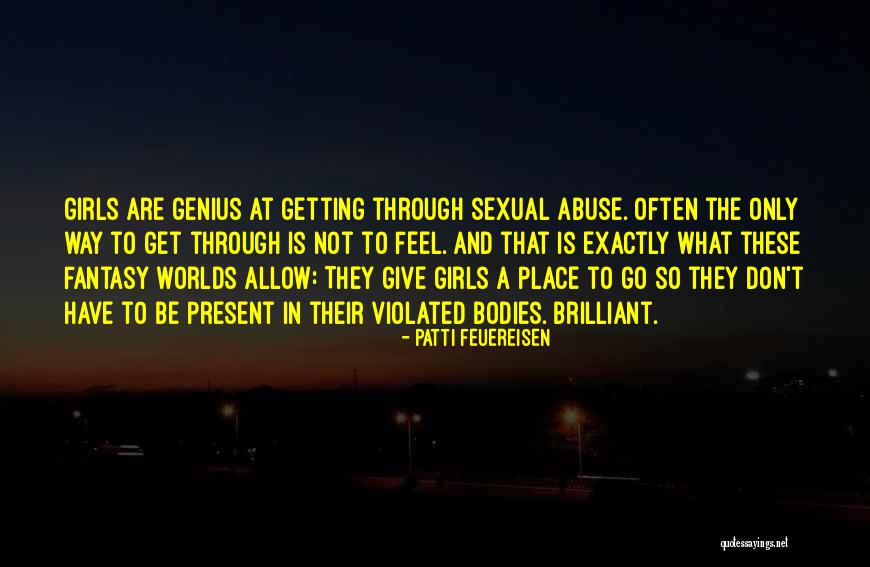
Girls are genius at getting through sexual abuse. Often the only way to get through is not to feel. And that is exactly what these fantasy worlds allow: They give girls a place to go so they don't have to be present in their violated bodies. Brilliant. — Patti Feuereisen

There is something servile in the interpretation of sin as crime which infringes the will of God and calls for legal proceedings on the part of God. Sin is dividedness, a state of deficiency, incompleteness, dissociation, enslavement, hatred, but it is not disobedience and not formal violation of the will of God. — Nikolai Berdyaev
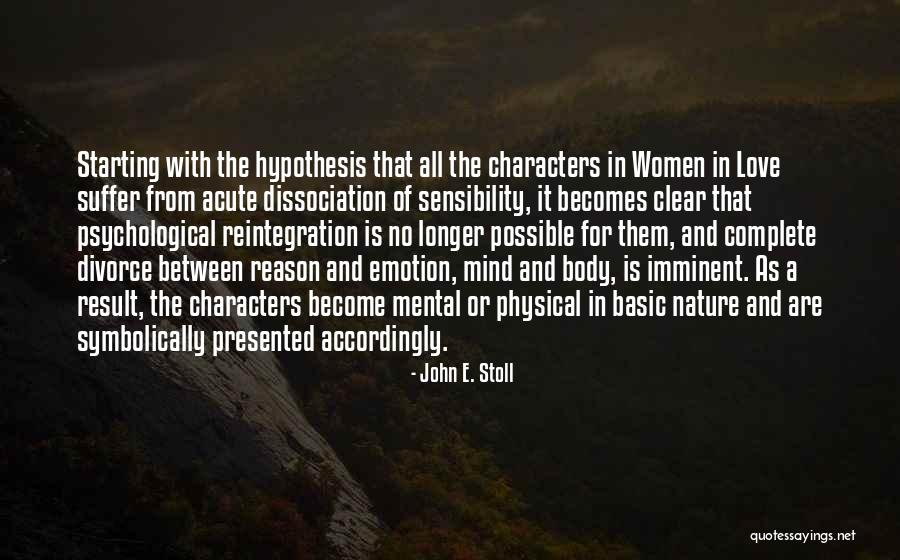
Starting with the hypothesis that all the characters in Women in Love suffer from acute dissociation of sensibility, it becomes clear that psychological reintegration is no longer possible for them, and complete divorce between reason and emotion, mind and body, is imminent. As a result, the characters become mental or physical in basic nature and are symbolically presented accordingly. — John E. Stoll
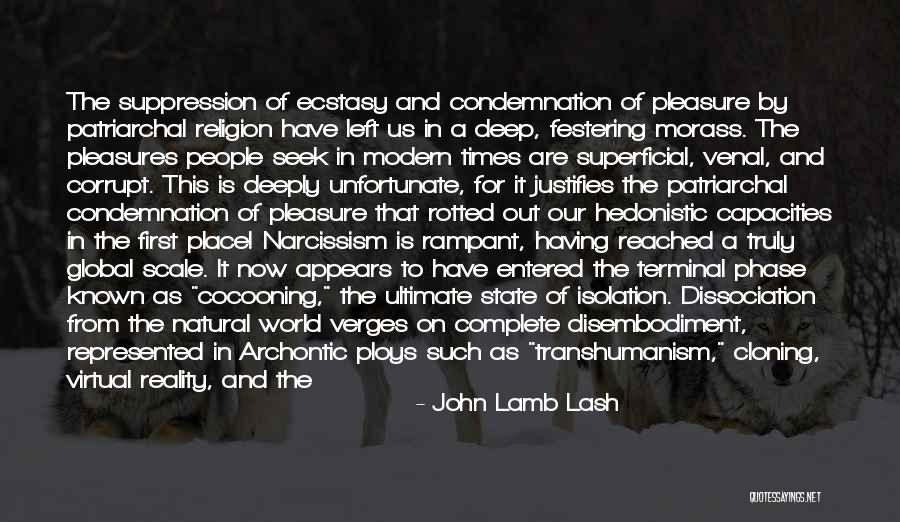
The suppression of ecstasy and condemnation of pleasure by patriarchal religion have left us in a deep, festering morass. The pleasures people seek in modern times are superficial, venal, and corrupt. This is deeply unfortunate, for it justifies the patriarchal condemnation of pleasure that rotted out our hedonistic capacities in the first place! Narcissism is rampant, having reached a truly global scale. It now appears to have entered the terminal phase known as "cocooning," the ultimate state of isolation. Dissociation from the natural world verges on complete disembodiment, represented in Archontic ploys such as "transhumanism," cloning, virtual reality, and the uploading of human consciousness into cyberspace. The computer looks due to replace the cross as the primary image of salvation. It is already the altar where millions worship daily. If the technocrats prevail, artificial intelligence and artificial life will soon overrule the natural order of the planet. — John Lamb Lash
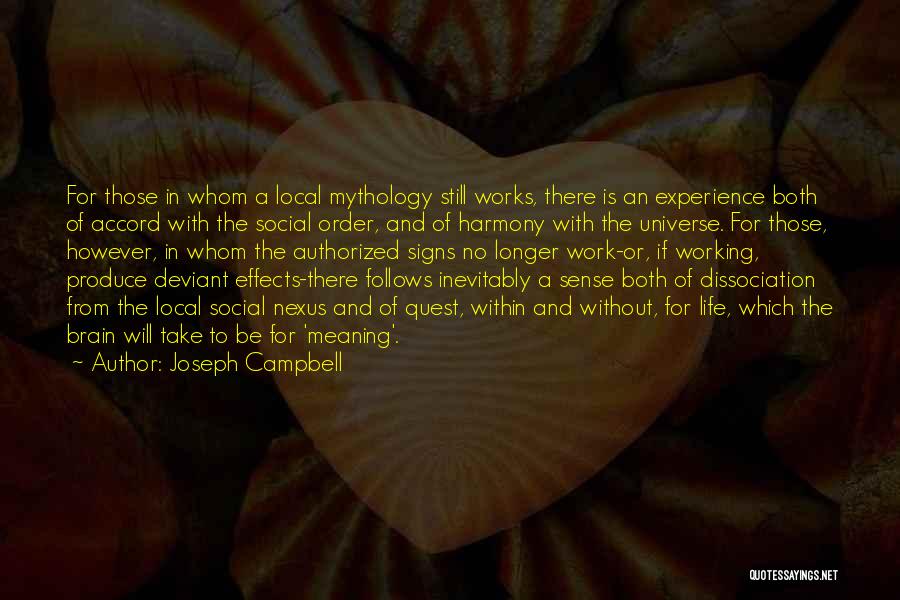
For those in whom a local mythology still works, there is an experience both of accord with the social order, and of harmony with the universe. For those, however, in whom the authorized signs no longer work-or, if working, produce deviant effects-there follows inevitably a sense both of dissociation from the local social nexus and of quest, within and without, for life, which the brain will take to be for 'meaning'. — Joseph Campbell
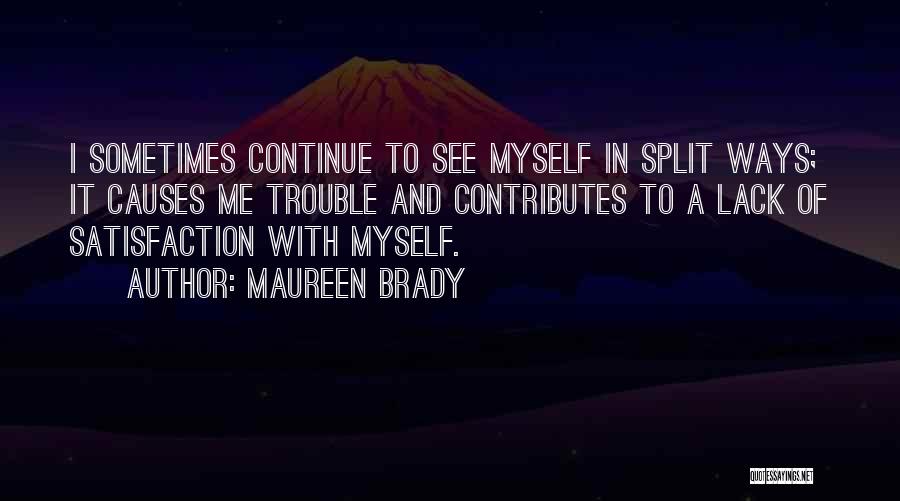
I sometimes continue to see myself in split ways; it causes me trouble and contributes to a lack of satisfaction with myself. — Maureen Brady
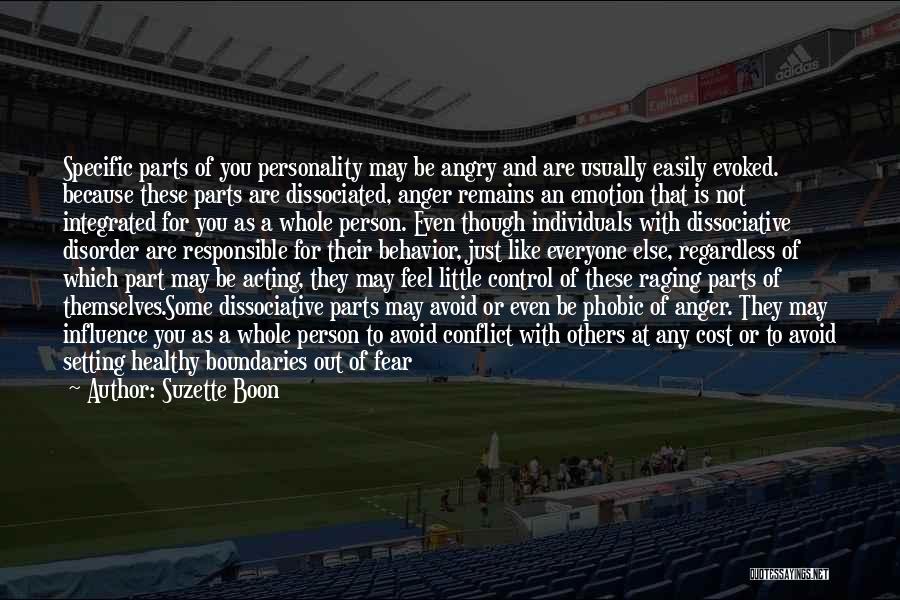
Specific parts of you personality may be angry and are usually easily evoked. because these parts are dissociated, anger remains an emotion that is not integrated for you as a whole person. Even though individuals with dissociative disorder are responsible for their behavior, just like everyone else, regardless of which part may be acting, they may feel little control of these raging parts of themselves.
Some dissociative parts may avoid or even be phobic of anger. They may influence you as a whole person to avoid conflict with others at any cost or to avoid setting healthy boundaries out of fear of someone else's anger; or they may urge you to withdraw from others almost completely. — Suzette Boon

For example, Dell (2009a) further explicitly asserts "that the domain of dissociative psychopathology is all of human experience. There is no human experience that is immune to invasion by the symptoms of pathological dissociation. Pathological dissociation can (and often does) affect seeing, hearing, smelling, tasting, touching, emoting, wanting, dreaming, intending, expecting, knowing, believing, recognizing, remembering, and so on" (Dell, 2009a, p. 228, emphasis in original). This — Paul Frewen
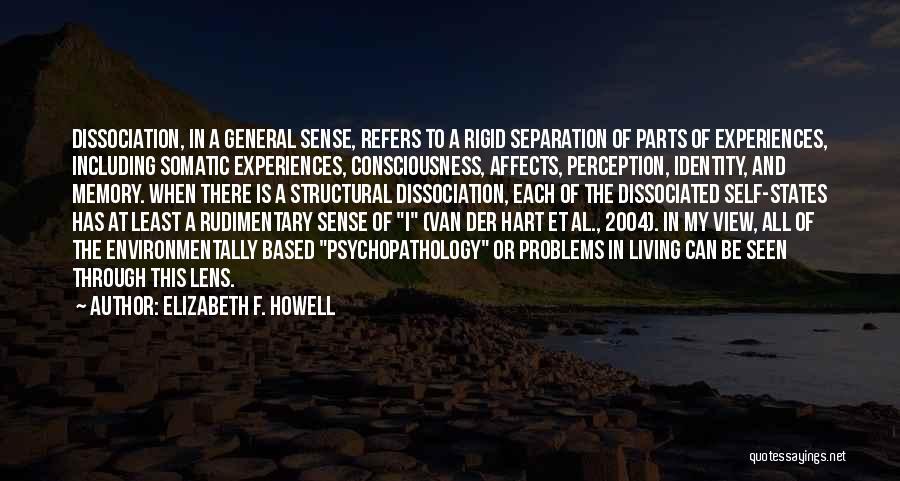
Dissociation, in a general sense, refers to a rigid separation of parts of experiences, including somatic experiences, consciousness, affects, perception, identity, and memory. When there is a structural dissociation, each of the dissociated self-states has at least a rudimentary sense of "I" (Van der Hart et al., 2004). In my view, all of the environmentally based "psychopathology" or problems in living can be seen through this lens. — Elizabeth F. Howell

Shortly after I began work with Teresa, I acquired another MPD client, a supposedly schizophrenic young man I will call Tony. He called in to the clinic on a day I was on telephone duty, saying he was having flashbacks of "ritual abuse." I did not yet know what that was. Tony became my client. He could be quite entertaining. I have a vivid memory of him as a three-year-old, "Tiny Tony," standing on his head on my office couch, and running down the hall to try unsuccessfully to make it to the bathroom. He had in his head the entire rock band of Guns'n'Roses, and I got to know Axl, the band leader, quite well. I remember the time Tony was in hospital and I went to visit him; Axl popped out and said, "Remember, we're schizophrenic in here! — Alison Miller

Posttraumatic stress disorder (PTSD) also has dissociative symptoms as an essential feature. PTSD has been classically seen as a biphasic disorder, with persons alternately experiencing phases of intrusion and numbing... [T]he intrusive phase is associated with recurrent and distressing recollections in thoughts or dreams and reliving the events in flashbacks. The avoidant/numbing phase is associated with efforts to avoid thoughts or feelings associated with the trauma, emotional constriction, and social withdrawal. This biphasic pattern is the result of dissociation; traumatic events are distanced and dissociated from usual conscious awareness in the numbing phase, only to return in the intrusive phase. — James A. Chu
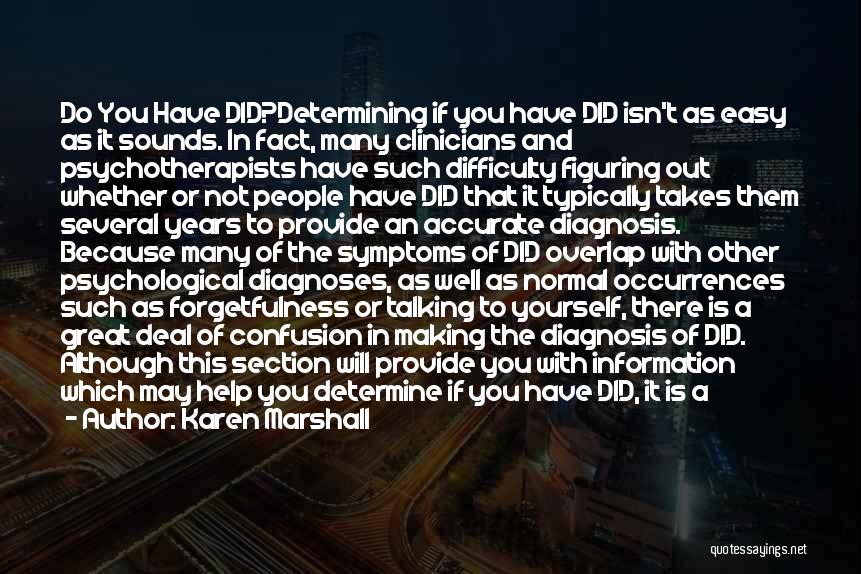
Do You Have DID?
Determining if you have DID isn't as easy as it sounds. In fact, many clinicians and psychotherapists have such difficulty figuring out whether or not people have DID that it typically takes them several years to provide an accurate diagnosis. Because many of the symptoms of DID overlap with other psychological diagnoses, as well as normal occurrences such as forgetfulness or talking to yourself, there is a great deal of confusion in making the diagnosis of DID. Although this section will provide you with information which may help you determine if you have DID, it is a good idea to consult with a professional in the mental health field so that you can have further confirmation of your findings. — Karen Marshall
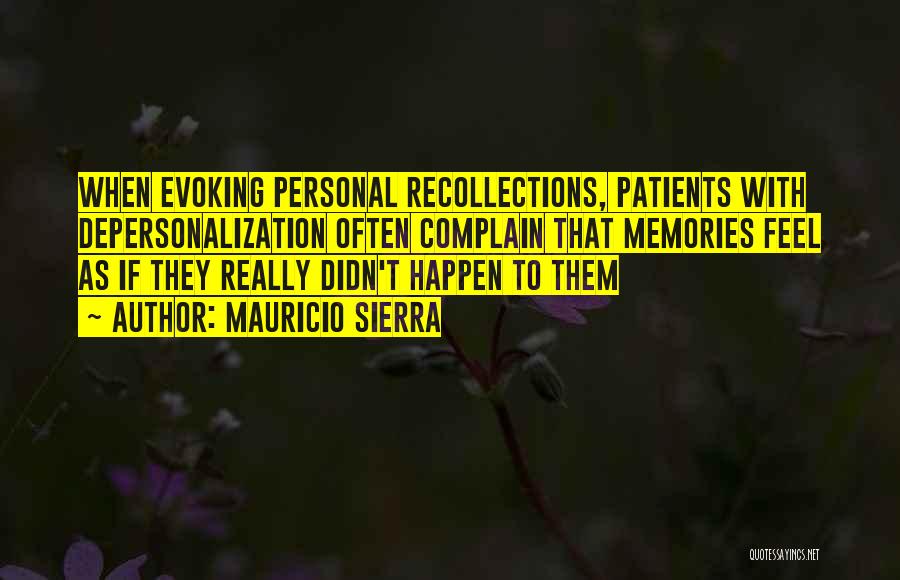
when evoking personal recollections, patients with depersonalization often complain that memories feel as if they really didn't happen to them — Mauricio Sierra
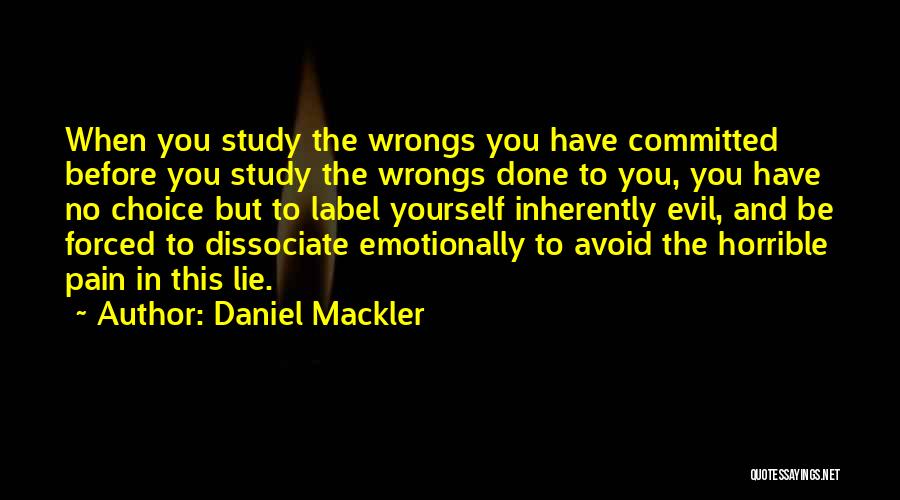
When you study the wrongs you have committed before you study the wrongs done to you, you have no choice but to label yourself inherently evil, and be forced to dissociate emotionally to avoid the horrible pain in this lie. — Daniel Mackler
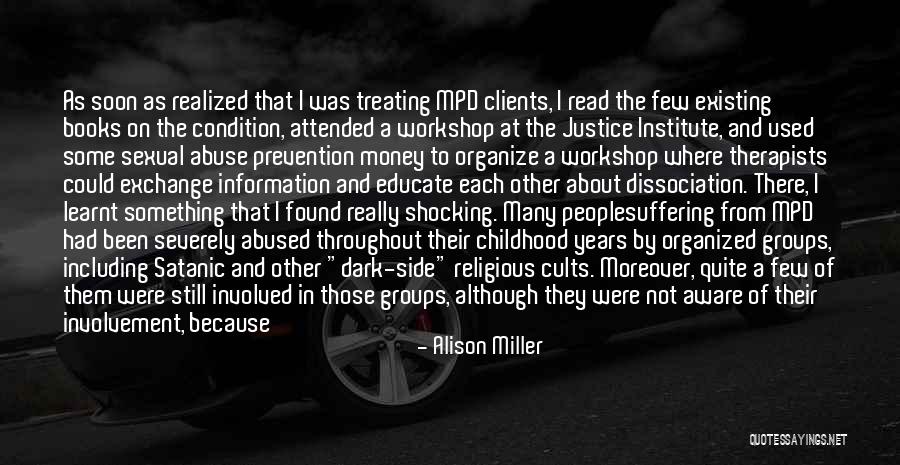
As soon as realized that I was treating MPD clients, I read the few existing books on the condition, attended a workshop at the Justice Institute, and used some sexual abuse prevention money to organize a workshop where therapists could exchange information and educate each other about dissociation. There, I learnt something that I found really shocking. Many people
suffering from MPD had been severely abused throughout their childhood years by organized groups, including Satanic and other "dark-side" religious cults. Moreover, quite a few of them were still involved in those groups, although they were not aware of their involvement, because it was other "personalities" - dissociated parts of them - who went off to the groups' rituals. I was skeptical, to say the least. — Alison Miller

This is an aspect of the modern "cultural" mind that is well worth looking into. It shows an alarming degree of dissociation and psychological confusion. — C. G. Jung

Denial is commonly found among persons with dissociative disorders. My favorite quotation from such a client is, "We are not multiple, we made it all up." I have heard this from several different clients. When I hear it, I politely inquire, "And who is we? — Alison Miller
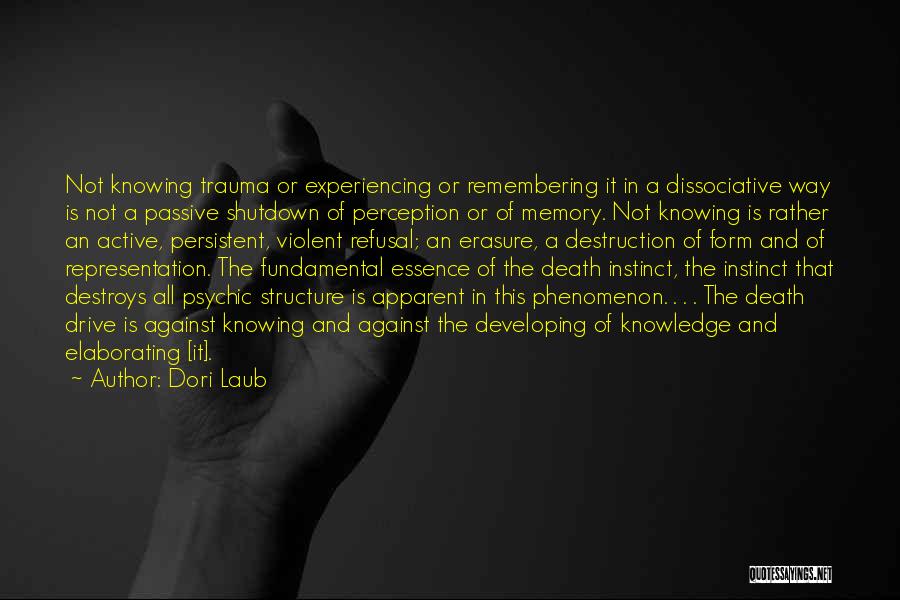
Not knowing trauma or experiencing or remembering it in a dissociative way is not a passive shutdown of perception or of memory. Not knowing is rather an active, persistent, violent refusal; an erasure, a destruction of form and of representation. The fundamental essence of the death instinct, the instinct that destroys all psychic structure is apparent in this phenomenon. . . . The death drive is against knowing and against the developing of knowledge and elaborating [it]. — Dori Laub
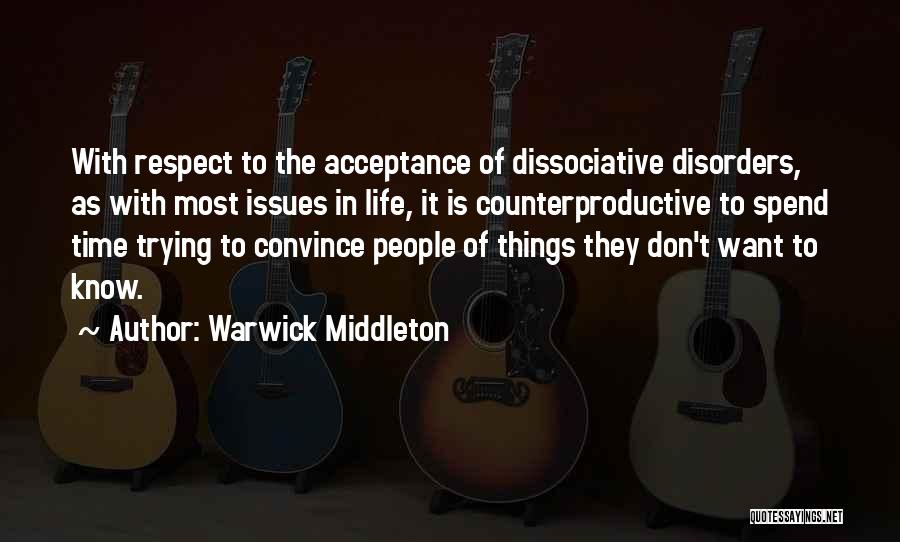
With respect to the acceptance of dissociative disorders, as with most issues in life, it is counterproductive to spend time trying to convince people of things they don't want to know. — Warwick Middleton

I'm not one of these people who are disheartened that the universe is expanding. But as news and data breed and the crowded channels grow ever noisier, I do feel that the space is ever increasing between me and it, whatever it might be. — Rivka Galchen
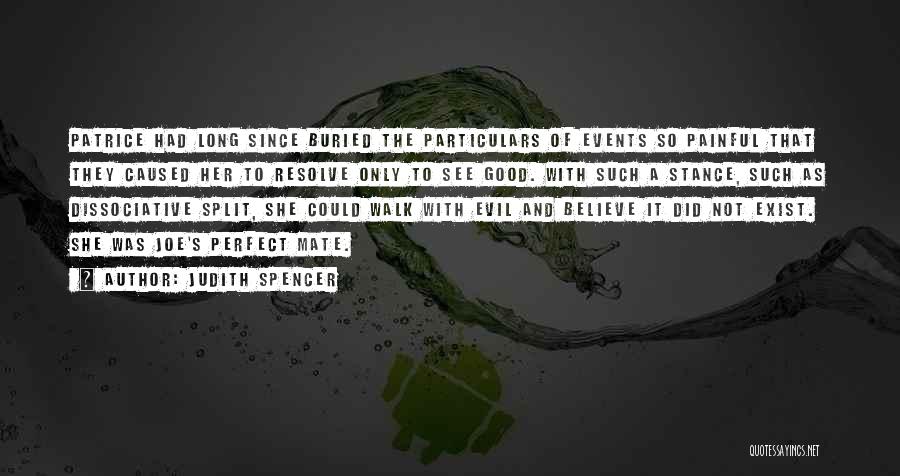
Patrice had long since buried the particulars of events so painful that they caused her to resolve only to see good. With such a stance, such as dissociative split, she could walk with evil and believe it did not exist. She was Joe's perfect mate. — Judith Spencer
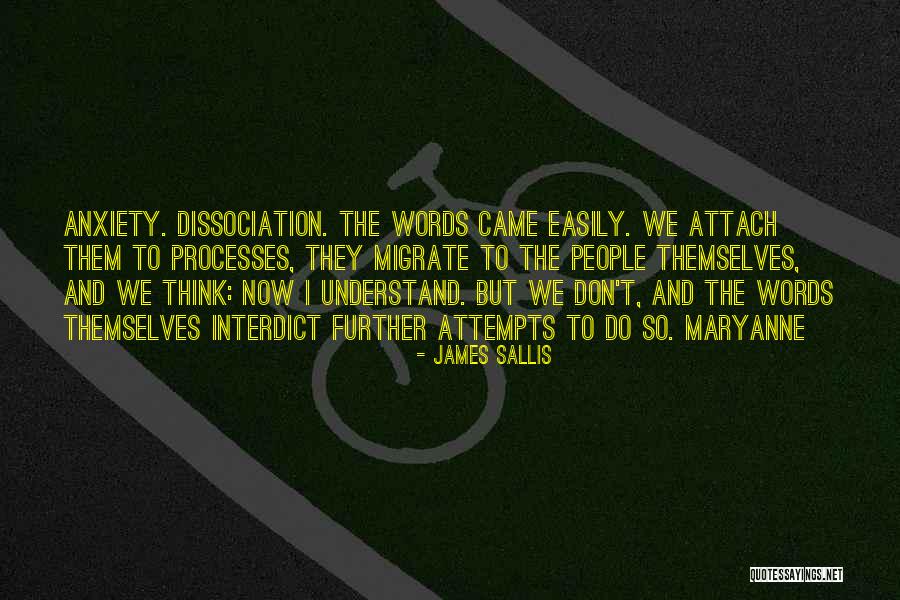
Anxiety. Dissociation. The words came easily. We attach them to processes, they migrate to the people themselves, and we think: Now I understand. But we don't, and the words themselves interdict further attempts to do so. Maryanne — James Sallis
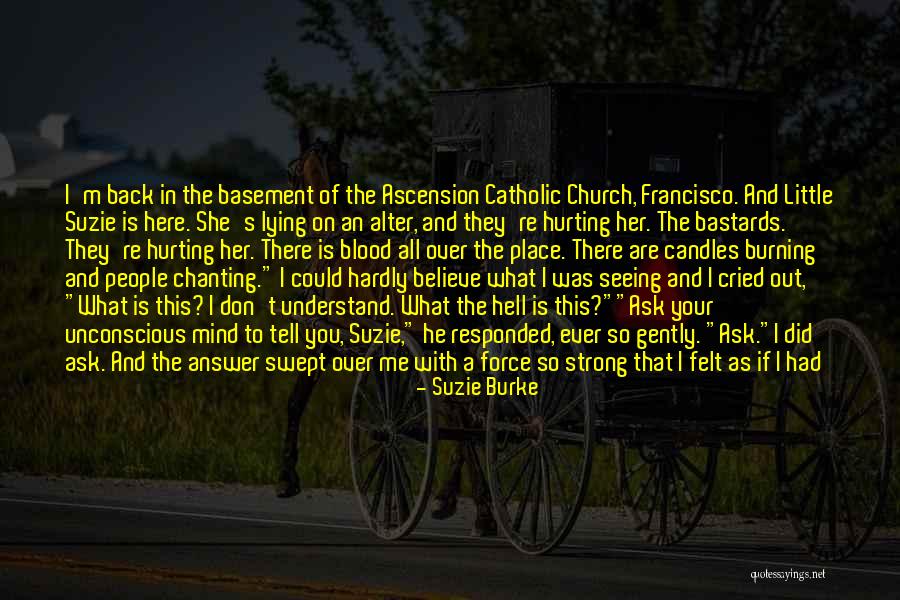
I'm back in the basement of the Ascension Catholic Church, Francisco. And Little Suzie is here. She's lying on an alter, and they're hurting her. The bastards. They're hurting her. There is blood all over the place. There are candles burning and people chanting." I could hardly believe what I was seeing and I cried out, "What is this? I don't understand. What the hell is this?"
"Ask your unconscious mind to tell you, Suzie," he responded, ever so gently. "Ask."
I did ask. And the answer swept over me with a force so strong that I felt as if I had been knocked backward.
"Lord! Oh, Lord. This is satanic ritual abuse, Francisco. That's what this is! That's what this is!" I screamed. "Satanic ritual abuse. And they're using Little Suzie as part of their goddamned ritual.
p150 — Suzie Burke
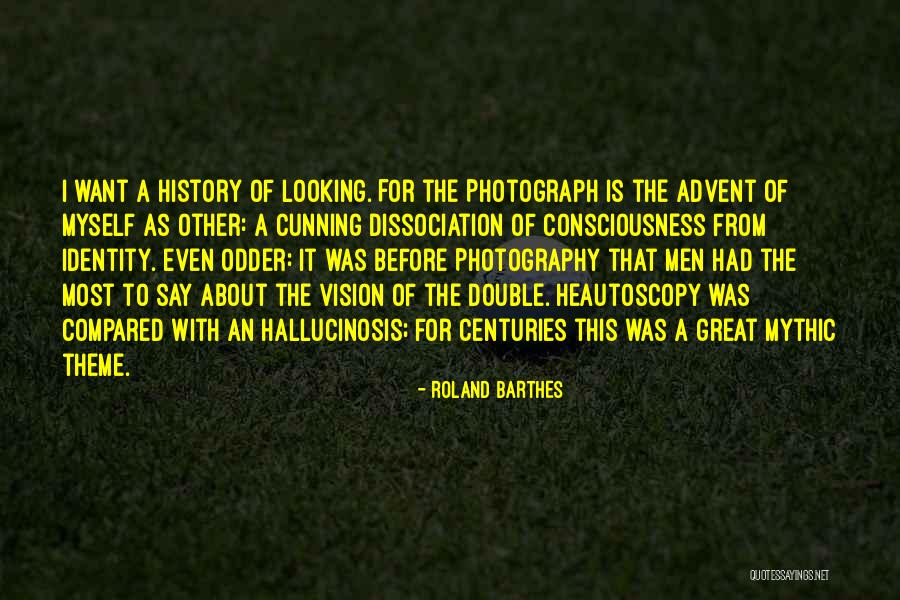
I want a History of Looking. For the Photograph is the advent of myself as other: a cunning dissociation of consciousness from identity. Even odder: it was before Photography that men had the most to say about the vision of the double. Heautoscopy was compared with an hallucinosis; for centuries this was a great mythic theme. — Roland Barthes
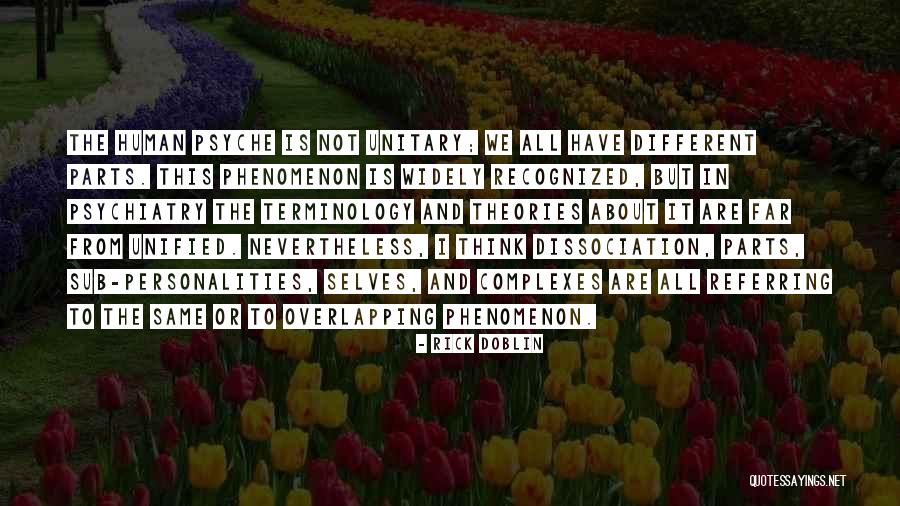
The human psyche is not unitary; we all have different parts. This phenomenon is widely recognized, but in psychiatry the terminology and theories about it are far from unified. Nevertheless, I think dissociation, parts, sub-personalities, selves, and complexes are all referring to the same or to overlapping phenomenon. — Rick Doblin

Without realizing it, I fought to keep my two worlds separated. Without ever knowing why, I made sure, whenever possible that nothing passed between the compartmentalization I had created between the day child and the night child.
p26 — Marilyn Van Derbur
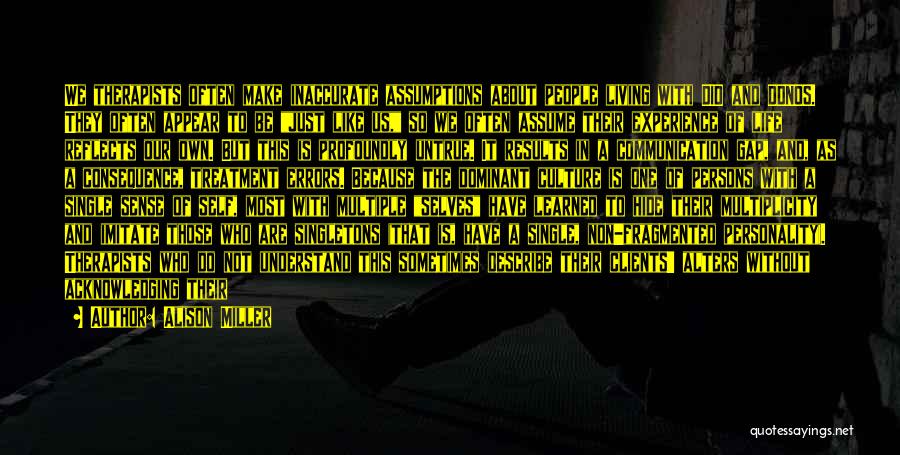
We therapists often make inaccurate assumptions about people living with DID and DDNOS. They often appear to be "just like us," so we often assume their experience of life reflects our own. But this is profoundly untrue. It results in a communication gap, and, as a consequence, treatment errors. Because the dominant culture is one of persons with a single sense of self, most with multiple "selves" have learned to hide their multiplicity and imitate those who are singletons (that is, have a single, non-fragmented personality). Therapists who do not understand this sometimes describe their clients' alters without acknowledging their dissociation, saying only that they have different "moods." In overlooking dissociation, this description fails to recognize the essential truth of such disorders, and of the alters. It was difficult for me to comprehend what life was like for my first few dissociative clients. — Alison Miller
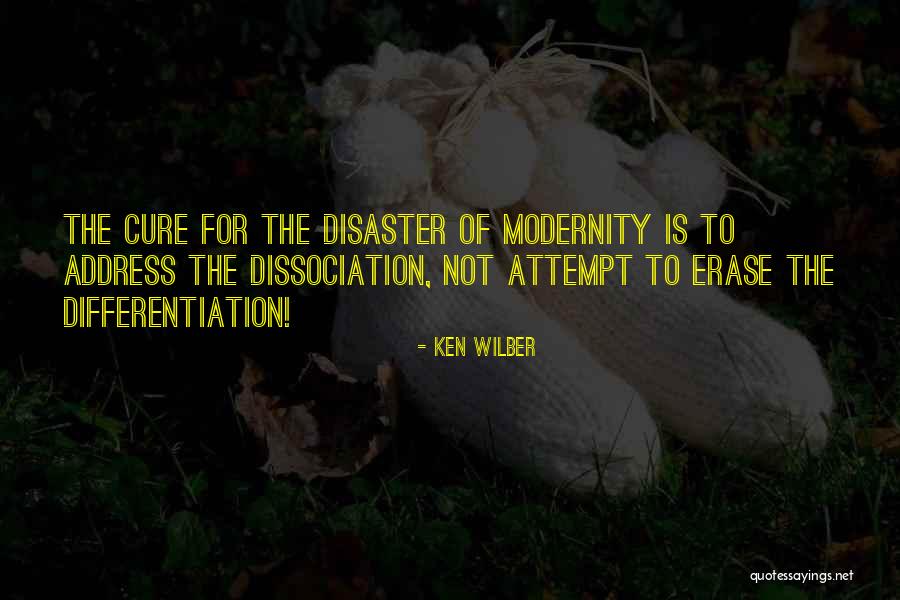
The cure for the disaster of modernity is to address the dissociation, not attempt to erase the differentiation! — Ken Wilber
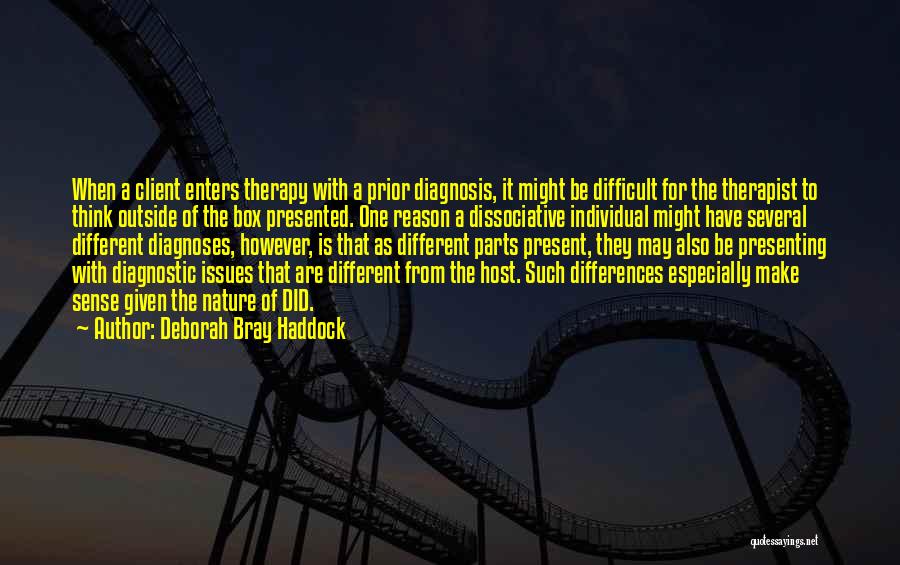
When a client enters therapy with a prior diagnosis, it might be difficult for the therapist to think outside of the box presented. One reason a dissociative individual might have several different diagnoses, however, is that as different parts present, they may also be presenting with diagnostic issues that are different from the host. Such differences especially make sense given the nature of DID. — Deborah Bray Haddock
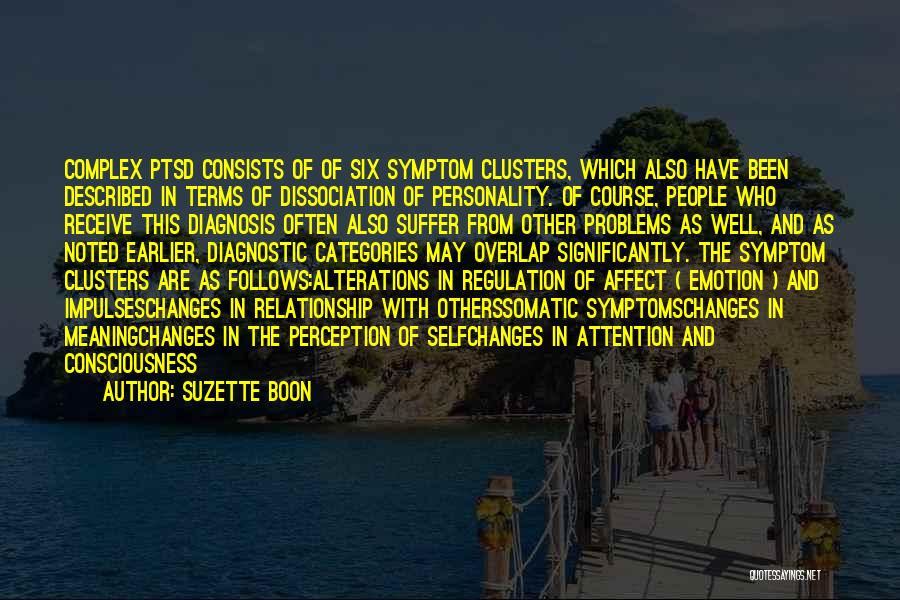
Complex PTSD consists of of six symptom clusters, which also have been described in terms of dissociation of personality. Of course, people who receive this diagnosis often also suffer from other problems as well, and as noted earlier, diagnostic categories may overlap significantly. The symptom clusters are as follows:
Alterations in Regulation of Affect ( Emotion ) and Impulses
Changes in Relationship with others
Somatic Symptoms
Changes in Meaning
Changes in the perception of Self
Changes in Attention and Consciousness — Suzette Boon

But I will stretch my toes so that they touch the rail at the end of the bed; I will assure myself, touching the rail, of something hard. Now I cannot sink; cannot altogether fall through the thin sheet now. Now I spread my body on this frail mattress and hang suspended. I am above the earth now. I am no longer upright, to be knocked against and damaged. All is soft, and bending. Walls and cupboards whiten and bend their yellow squares on top of which a pale glass gleams. Out of me now my mind can pour. — Virginia Woolf

In addition to localized neural networks, hallucinogenic drugs have been documented to trigger such preternatural experiences, such as the sense of floating and flying stimulated by atropine and other belladonna alkaloids. These can be found in mandrake and jimsonweed and were used by European witches and American Indian shamans, probably for this very purpose.32 Dissociative anesthetics such as the ketamines are also known to induce out-of-body experiences. Ingestion of methylenedioxyamphetamine (MDA) may bring back long-forgotten memories and produce the feeling of age regression, while dimethyltryptamine (DMT) - also known as "the spirit molecule" - causes the dissociation of the mind from the body and is the hallucinogenic substance in ayahuasca, a drug taken by South American shamans. People who have taken DMT report "I no longer have a body," and "I am falling," "flying," or "lifting up. — Michael Shermer
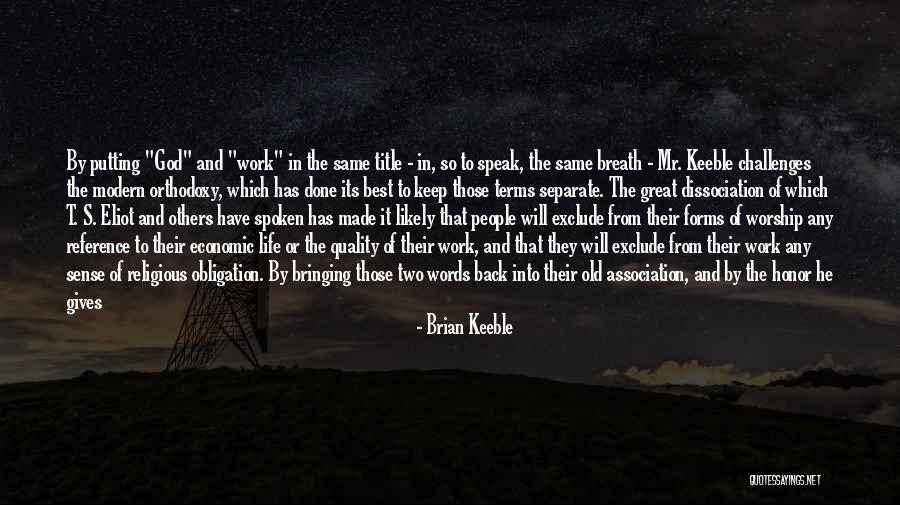
By putting "God" and "work" in the same title - in, so to speak, the same breath - Mr. Keeble challenges the modern orthodoxy, which has done its best to keep those terms separate. The great dissociation of which T. S. Eliot and others have spoken has made it likely that people will exclude from their forms of worship any reference to their economic life or the quality of their work, and that they will exclude from their work any sense of religious obligation. By bringing those two words back into their old association, and by the honor he gives to people who conscientiously kept them associated, Mr. Keeble restores to practical viability the idea of good work. He brings again into view the possibility of religion practicable in work, and work compatible with worship and wholly meant. Wendell Berry Lanes Landing Farm Port Royal, Kentucky — Brian Keeble

The observer self, a part of who we really are, is that part of us that is watching both our false self and our True Self. We might say that it even watches us when we watch. It is our Consciousness, it is the core experience of our Child Within. It thus cannot be watched - at least by anything or any being that we know of on this earth. It transcends our five senses, our co-dependent self and all other lower, though necessary parts, of us.
Adult children may confuse their observer self with a kind of defense they may have used to avoid their Real Self and all of its feelings. One might call this defense "false observer self" since its awareness is clouded. It is unfocused as it "spaces" or "numbs out." It denies and distorts our Child Within, and is often judgmental. — Charles L. Whitfield
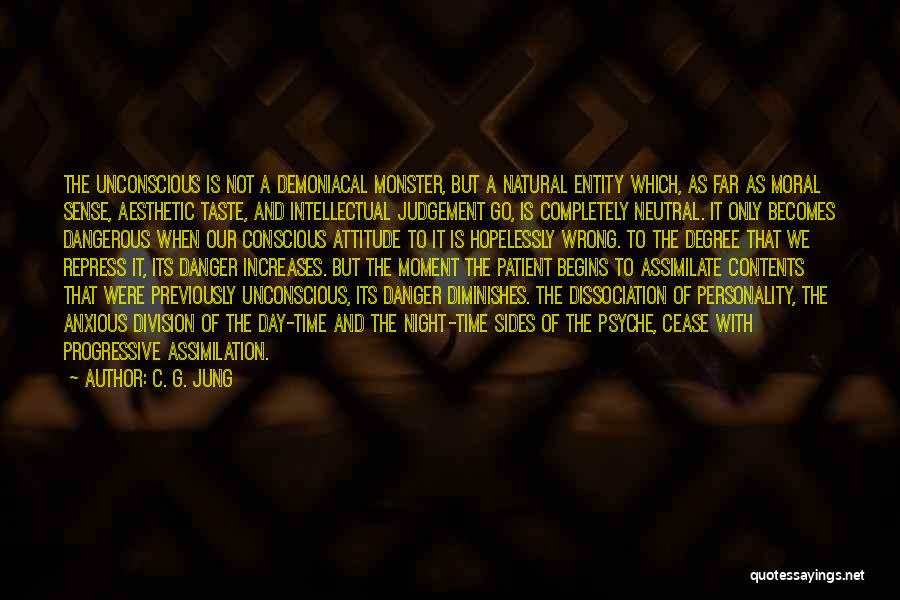
The unconscious is not a demoniacal monster, but a natural entity which, as far as moral sense, aesthetic taste, and intellectual judgement go, is completely neutral. It only becomes dangerous when our conscious attitude to it is hopelessly wrong. To the degree that we repress it, its danger increases. But the moment the patient begins to assimilate contents that were previously unconscious, its danger diminishes. The dissociation of personality, the anxious division of the day-time and the night-time sides of the psyche, cease with progressive assimilation. — C. G. Jung
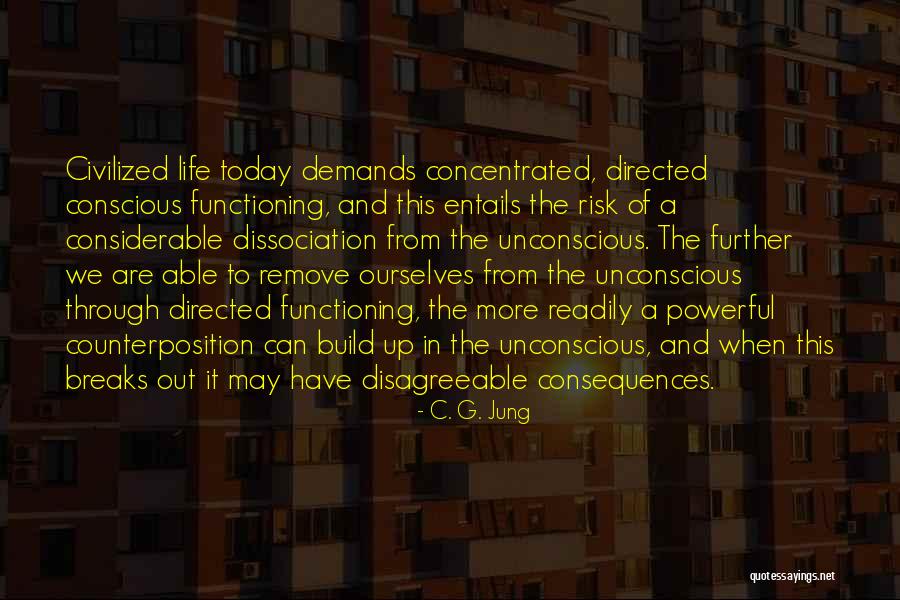
Civilized life today demands concentrated, directed conscious functioning, and this entails the risk of a considerable dissociation from the unconscious. The further we are able to remove ourselves from the unconscious through directed functioning, the more readily a powerful counterposition can build up in the unconscious, and when this breaks out it may have disagreeable consequences. — C. G. Jung
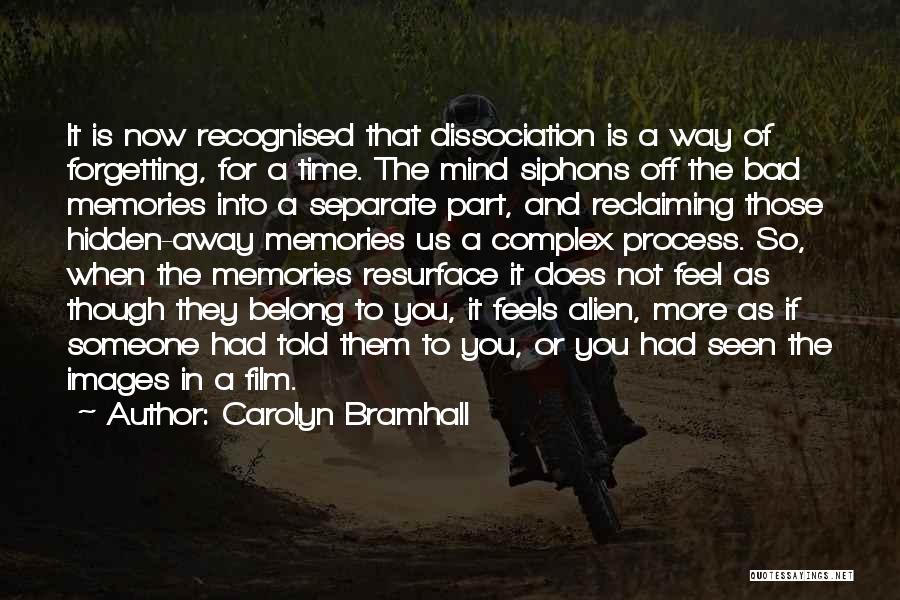
It is now recognised that dissociation is a way of forgetting, for a time. The mind siphons off the bad memories into a separate part, and reclaiming those hidden-away memories us a complex process. So, when the memories resurface it does not feel as though they belong to you, it feels alien, more as if someone had told them to you, or you had seen the images in a film. — Carolyn Bramhall

If dissociation, then, has been understood by psychopathologists to imply among other things 'loss of consciousness,' the question that immediately presents itself, or so one might think, is: what exactly is being lost--in other words, what is meant by consciousness? It turns out that it is exceedingly difficult to find an answer to this question in the psychiatric literature despite the seeming centrality of the issue. — Morton Klass
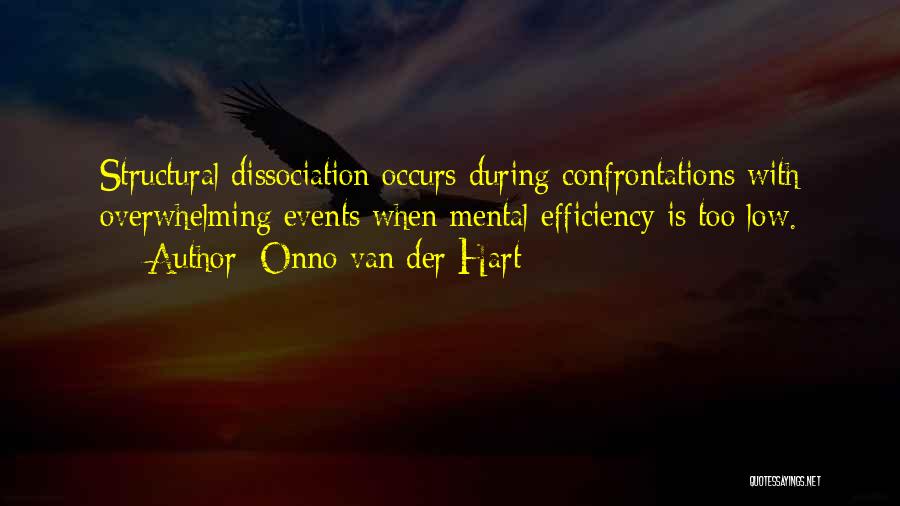
Structural dissociation occurs during confrontations with overwhelming events when mental efficiency is too low. — Onno Van Der Hart

Another of the difficulties of having DID is the denial. DID is a disorder of denial. It has to be because if the original person knew about the alters and felt their pain, they would either go crazy and be hospitalized permanently, or would die. — Eve N. Adams
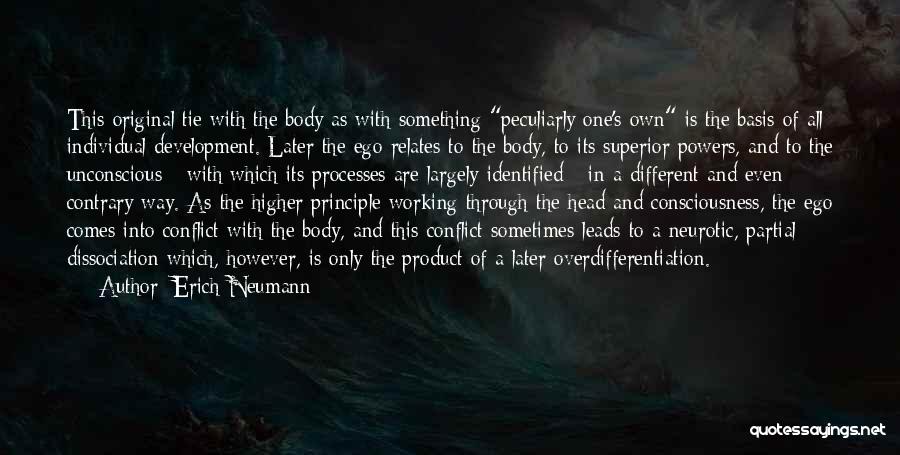
This original tie with the body as with something "peculiarly one's own" is the basis of all individual development. Later the ego relates to the body, to its superior powers, and to the unconscious - with which its processes are largely identified - in a different and even contrary way. As the higher principle working through the head and consciousness, the ego comes into conflict with the body, and this conflict sometimes leads to a neurotic, partial dissociation which, however, is only the product of a later overdifferentiation. — Erich Neumann
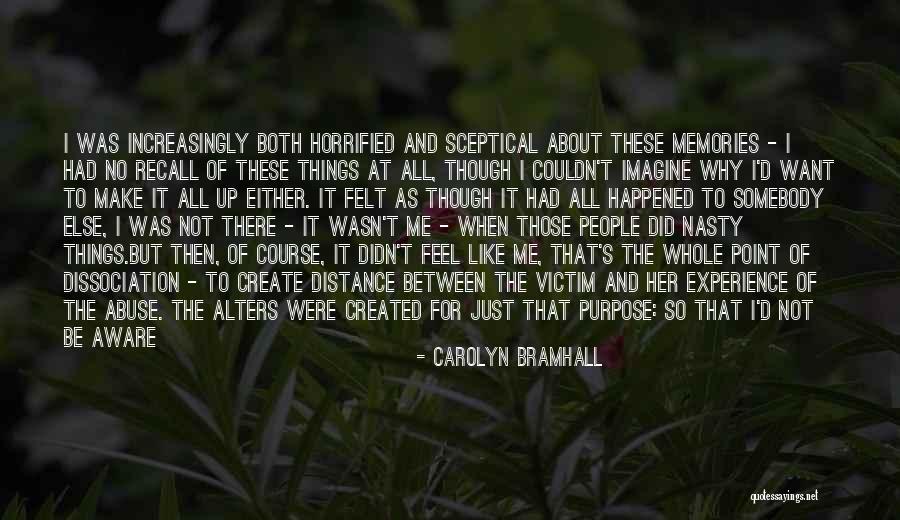
I was increasingly both horrified and sceptical about these memories - I had no recall of these things at all, though I couldn't imagine why I'd want to make it all up either. It felt as though it had all happened to somebody else, I was not there - it wasn't me - when those people did nasty things.
But then, of course, it didn't feel like me, that's the whole point of dissociation - to create distance between the victim and her experience of the abuse. The alters were created for just that purpose: so that I'd not be aware that it happened to me, but rather to "others". The trouble is, in reality it was my body that took the abuse. It was only my mind that was divided, and sooner or later the amnesic barriers were bound to come down.
And that's exactly what had begun to happen as I heard their stories. They triggered a vague and growing sense in me that this really is my story. — Carolyn Bramhall
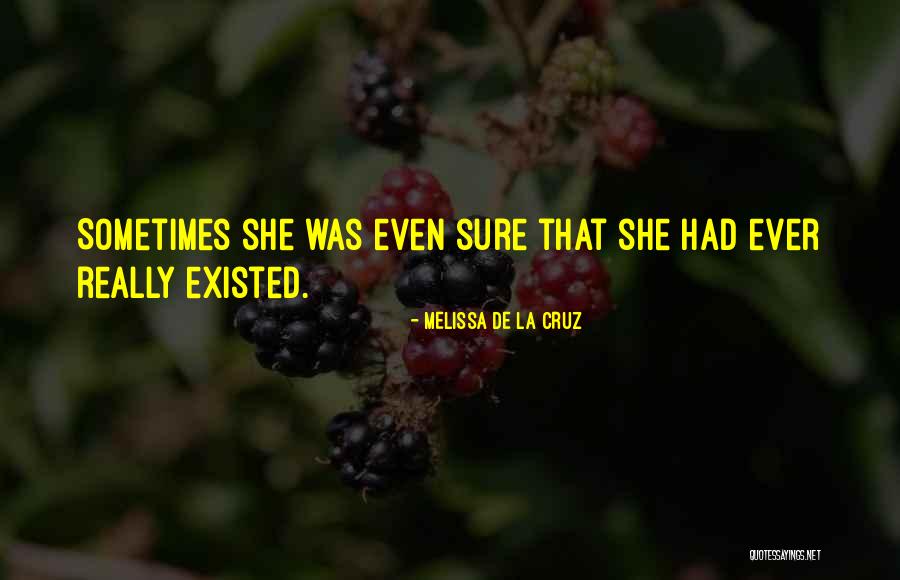
Sometimes she was even sure that she had ever really existed. — Melissa De La Cruz
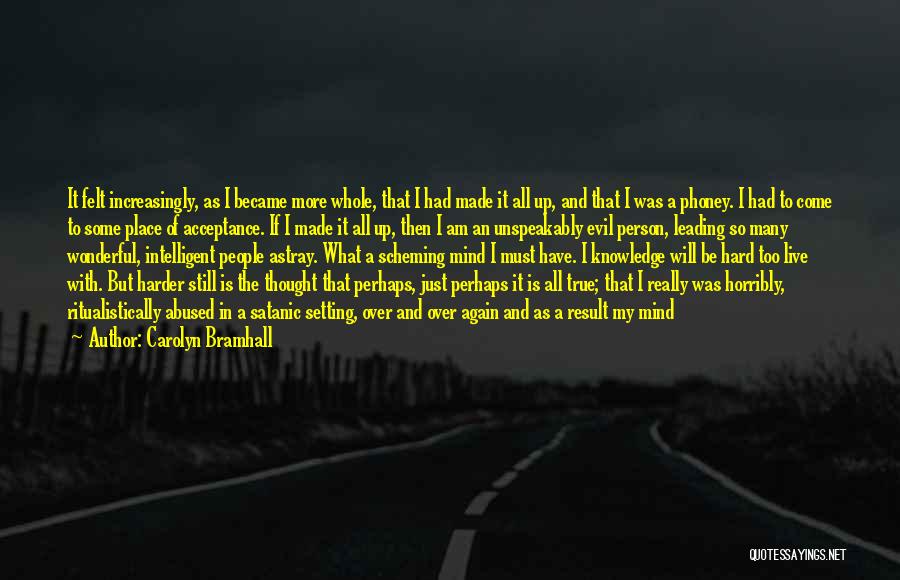
It felt increasingly, as I became more whole, that I had made it all up, and that I was a phoney. I had to come to some place of acceptance. If I made it all up, then I am an unspeakably evil person, leading so many wonderful, intelligent people astray. What a scheming mind I must have. I knowledge will be hard too live with. But harder still is the thought that perhaps, just perhaps it is all true; that I really was horribly, ritualistically abused in a satanic setting, over and over again and as a result my mind fragmented. The implications of that are completely overwhelming. It was me, my body, that they did those things to. No, I would rather believe I am an evil and deceitful person. At least the I can change, and say sorry, and live a better life from now on. — Carolyn Bramhall
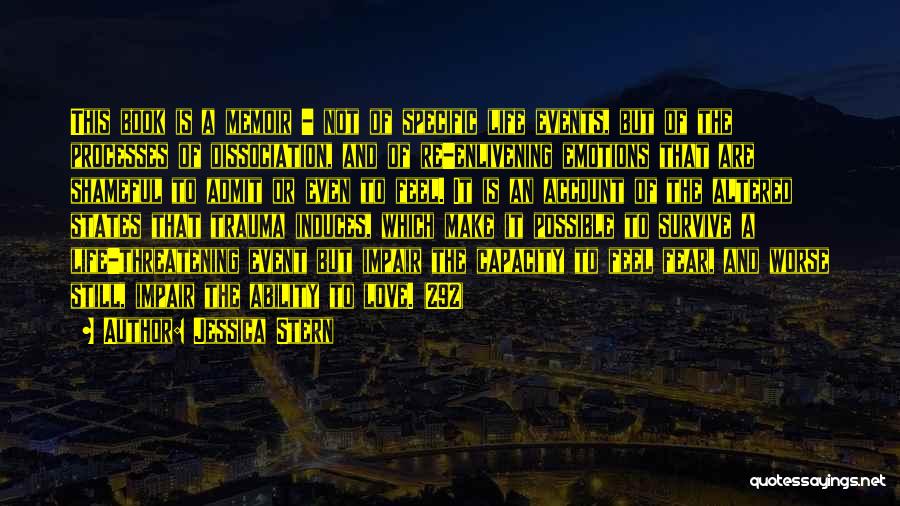
This book is a memoir - not of specific life events, but of the processes of dissociation, and of re-enlivening emotions that are shameful to admit or even to feel. It is an account of the altered states that trauma induces, which make it possible to survive a life-threatening event but impair the capacity to feel fear, and worse still, impair the ability to love. (292) — Jessica Stern
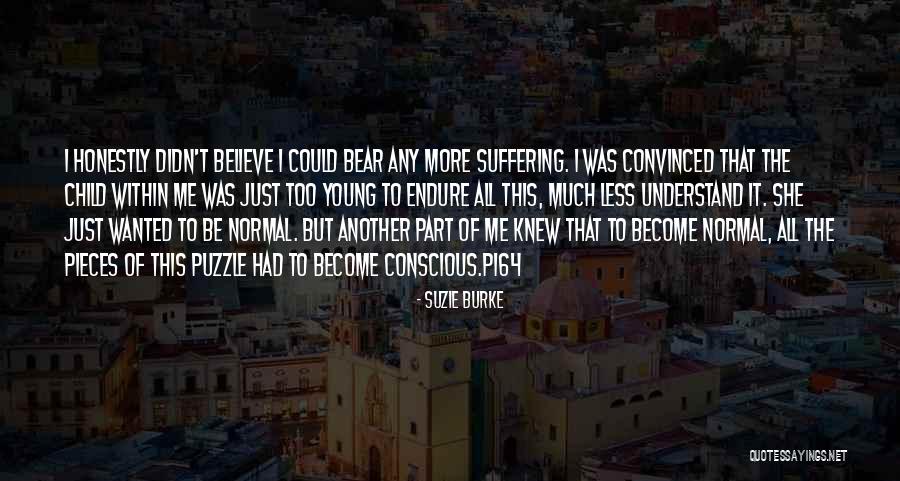
I honestly didn't believe I could bear any more suffering. I was convinced that the child within me was just too young to endure all this, much less understand it. She just wanted to be normal. But another part of me knew that to become normal, all the pieces of this puzzle had to become conscious.
p164 — Suzie Burke

Indeed, she often wondered if she were dead, or dying from the inside out, and that was the root of her calm, the reason she could surrender her character. — Gregory Maguire
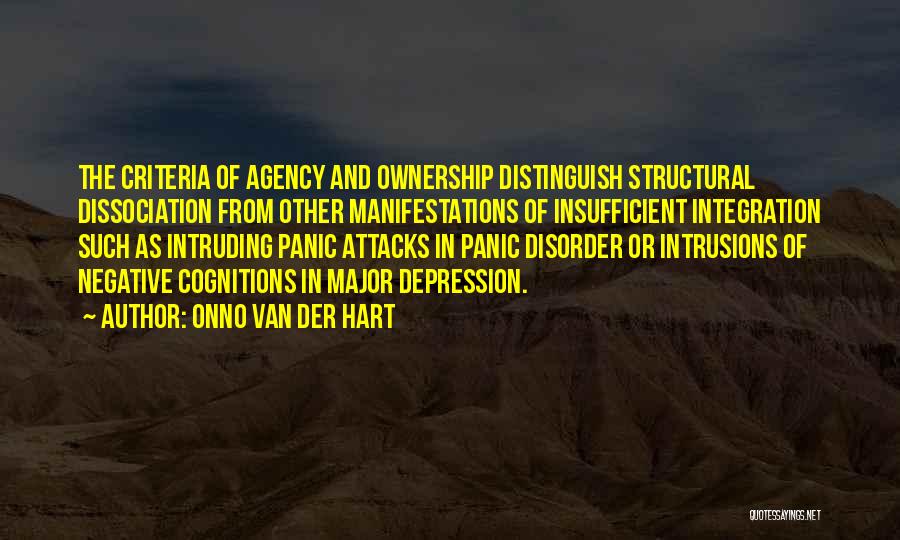
The criteria of agency and ownership distinguish structural dissociation from other manifestations of insufficient integration such as intruding panic attacks in panic disorder or intrusions of negative cognitions in major depression. — Onno Van Der Hart





